King of Sports and King of Beers
Would you do it again? I seek the answer at Seattle Clipper Race Village where I spot a childhood hero, Robin Johnston. He notices that I have taken his picture but is busy. I look for my answer from other Clipper Race participants. Perhaps 40 percent of the close to 700 crew on 12 race boats will sail across only one ocean.
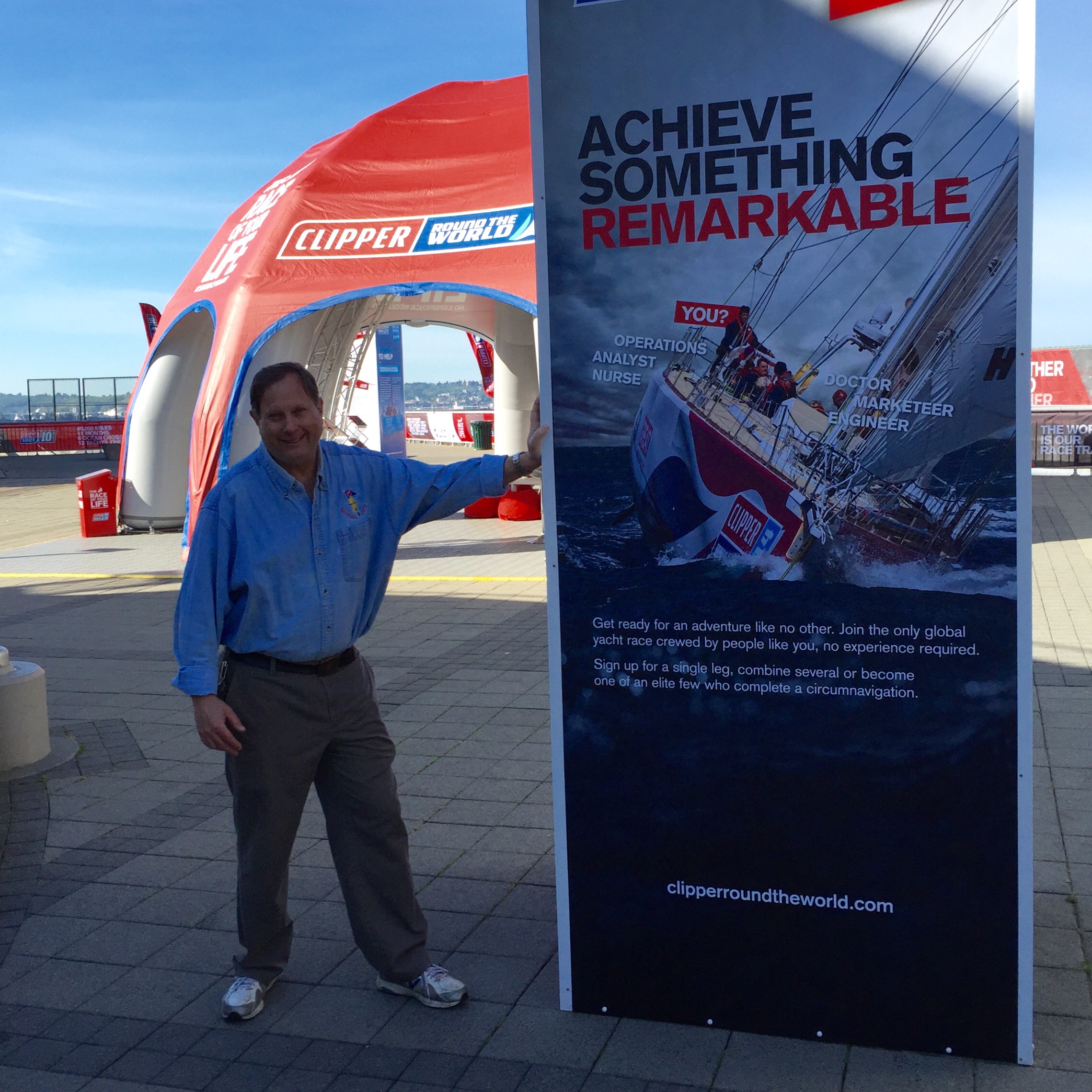
Friends and family have gathered and a banner saying 7 mountains and 7 seas is unfurled. The banner is for a Face Book friend that after retiring from a Tech Company decided to climb and latter sail for adventure. His boat, Visit Seattle, pulls in while Dave, a sailor working now for Clipper race, confirms that sir Robert Knox Johnston is greeting the vessel. It is 8 AM and I notice beer on the dock. Some one from the boat asks about the beer before a line is tossed.
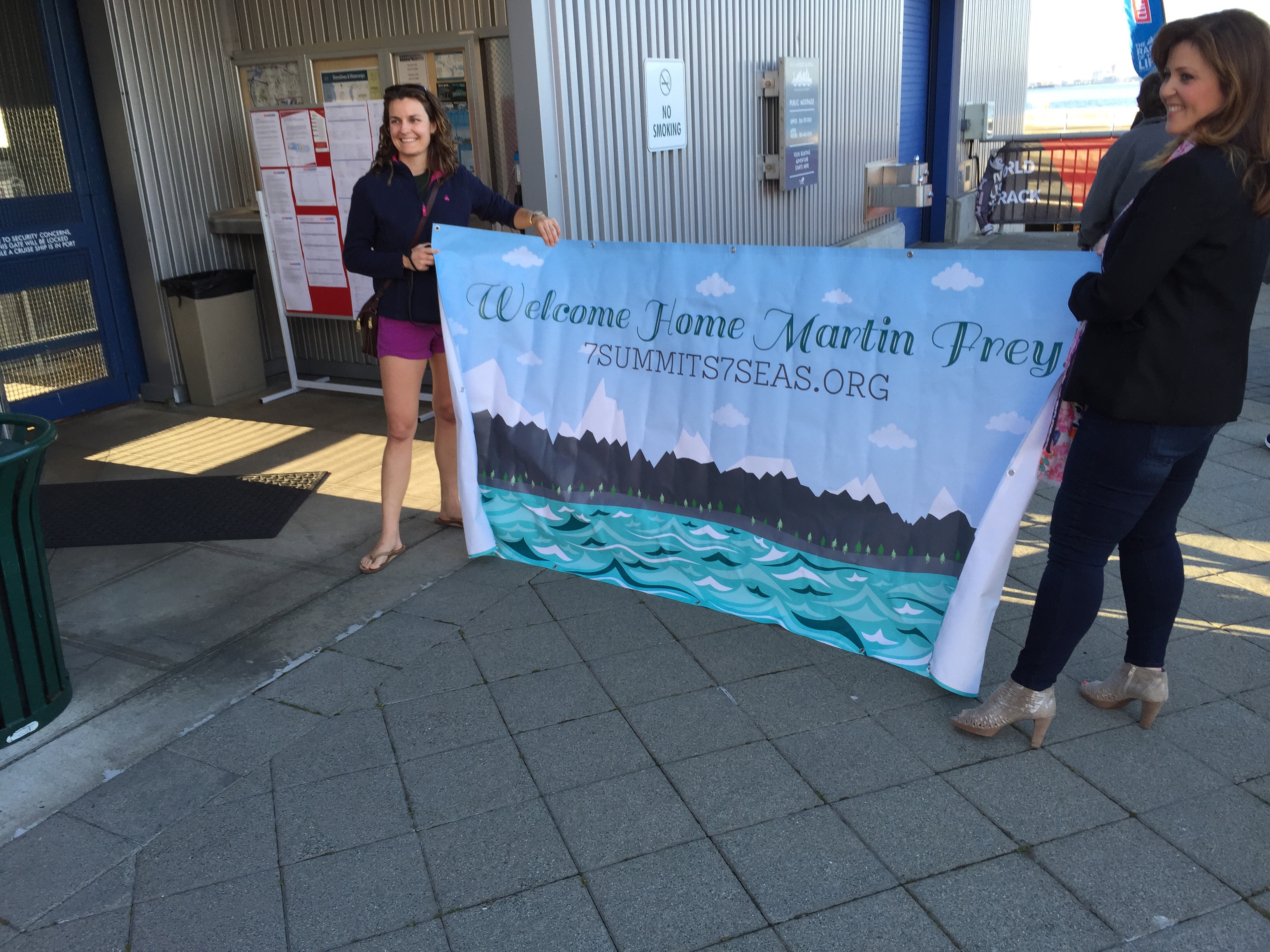
Johnston single handled a 32 foot ketch around the world in the Golden Globe race, a race won by Johnston. This is the race where Donald Crowhurst fooled the world with transmissions making it appear he had circumnavigated in his trimaran when he had actually waited to join Johnston and others who had done so. Crowhurst intended to satisfy his sponsors by appearing to complete the race and likely wanted to avoid race official scrutiny that would come from a podium finish. Upon realizing that he was expected to place and after the accomplished French/Vietnam sailor Bernard Moitessier sailed away from the finish line (possibly to avoid marital obligations), Crowhurst abandoned his boat and drowned himself. This was in 1969. Johnston was knighted 30 years latter for winning the Golden Globe. He had become interested in the race because of Moitessier, who with his first wife, Francoise had completed the longest non stop passage by a yacht in history, which brought them immediate recognition throughout the yachting world. It takes decades for recognition in Britton. Johnston has sailed competitively throughout his life including the Whitbread (renamed Volvo Océan Race) and last December the Sydney Hobart. He competed in the solo Transatlantic Route de Rhum Race in 2014 and the Transatlantic Race in 2015.
The beer sits untasted on the dock, owing to US Custom official policy. It is not Whitbread Beer. The The British Firm Whitbread, had moved to other business opportunities. Nothing on or off Clipper Race Boat Visit Seattle until all crew present passports and are checked in by customs. Beer is important to the Clipper Race and to sailors in general.
The Royal Navy banned alcohol in 1970, ending the British tradition of the daily tot, which today is referred to as happy hour. But prior to then, alcohol was believed beneficial in keeping sailors limber and brave. A keg of Whitbread Beer accompanied Francis Chichester, knighted in 1972, on board Gypsy moth 4 for his 1967 single-handed circumnavigation and this keg was greatly appreciated. Chichester was 65 years old when he circumnavigated with Whitbread Beer. Johnston, in 2016, is a decade older.
Wisdom is often accompanied by age. Chichester wisely knew that his boat would capsize at least once in the Southern Ocean and hence had the boat specially rigged to withstand such events. Mono hulled boats like Gypsy Moth 4 and the Clipper race boats, right themselves after capsize. This is not the case with multi hulled boats. These float upside down so that crew must be rescued. Capsized multihulls are recovered floating upside down, sometimes years later.
Johnston is wise beyond ocean racing. He talks politics with me for 20 minutes. Later I read that he is one of the most influential men in Britain. Johnston does not route the Clipper Race where Chichester experienced capsize. Instead, his fleet of 12 identical 70 foot racers utilize the Panama Canal. The next stop after Seattle will be in Panama. He looks forward to news about the Panama Papers as I am unable to explain the scandal which involves avoiding tax and funding terrorism. Several current and former British territories are involved. The British Prime Minister’s family is implicated.
The British coined the term “King of Sports” and applied this term to ocean racing in 1800s. Back then the sport involved races that were off coastal shores and as far as out into the ocean as the Fastnet Rock, near the south-eastern tip of Ireland. The endeavors were by amateurs with royals of course involved. Johnston orients his clipper races to amateurs (sometimes called corinthians in the US.) His goal is to open the king of sports to all, not just those who may be considered professionals.
I follow up with Dave and we try to define a professional sailor. Certainly someone who is paid to deliver a boat across an ocean is a professional. Such a person would do it again if fully compensated for the risk. But beyond that, the two of us can not distinguish between on board race participants in the Clipper Race and on board participants in other sailboat races, such as the Volvo Ocean Race or even the America’s Cup. The Olympics had the same problem in making the professional vs amateur distinction, finally dropping the notion that there is a difference. Several sailing champions in word competitions including the Olympics pay Johnston to participate in the Clipper Race. When I get back to my yacht club, I reference a book called Ocean Racing Around The World. Here I learn that the schooner America was sailed across the North Atlantic ocean to be sold for profit on the south coast of England. There, with Queen Victoria watching, schooner America bettered all other vessels in a race. One explanation given for this embarrassment was that the schooner was crewed by paid ocean passage makers, in other words professionals.
Yacht racing had almost died out in England until schooner America won the race in 1851. Royalty was watching because Cowes on the Isle of Wight was a fashionable spot. Americans became England’s traditional yachting adversary from then on. Ocean racing was mostly a way for owners to reach new cruising grounds and Americans enjoyed bringing newly built boats to Cowes by racing across the North Atlantic. In 1924, Weston Martyr lamented in the December edition of Yachting Monthly that England had plenty of boats that could go to sea but that English crews simply did not take them there. He created the Fastnet Race which qualifies as an ocean race but is mostly the more dangerous coastal ocean form of racing.
The Fastnet and the Sydney Hobart races are two of the most notorious ocean races because of shallows which contribute to rough sea states. In 2015, the Fastnet was completed by Clipper Race crew in an older Clipper 68 foot race boat and the Sydney Hobart is a portion of the 15/16 newer Clipper 70 Race boat circumnavigation. Clipper 70 race boats participate in Cowes Week races on Inshore courses. The Cowes Week, Fastnet and a race across the English Channel comprised the Admirals Cup which was the catalyst in making ocean racing highly competitive between England and the USA. The last Admirals Cup was in 2005.
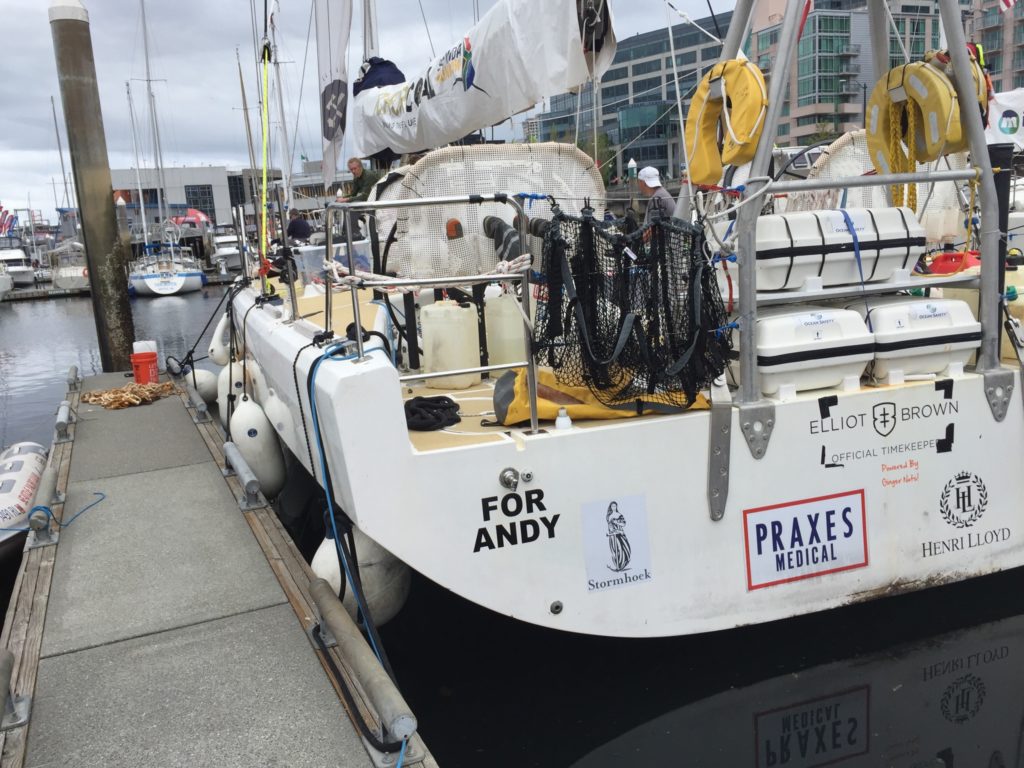
Crew member lost
Returning to the race village a few days later, I am delighted by a young woman who remains enthusiastic about ocean racing – in spite of the loss of two crew members. She wanted to chat about the losses. This surprises me. That usually isn’t done (on the docks) in my US sailing groups. Johnston had briefed me days before, telling me that the unlucky captain of the race boat with lost crew was returning to England to assist with inquiries. In my country, an inquiry typically means a gag order and discussion takes place in law breaking secret or with bereavement counsellors. The young lady confirms that, after the first loss, there were counsellors. As far as she knew, none were planned for the second. A burial at sea had taken place and there had been a private service in Seattle.
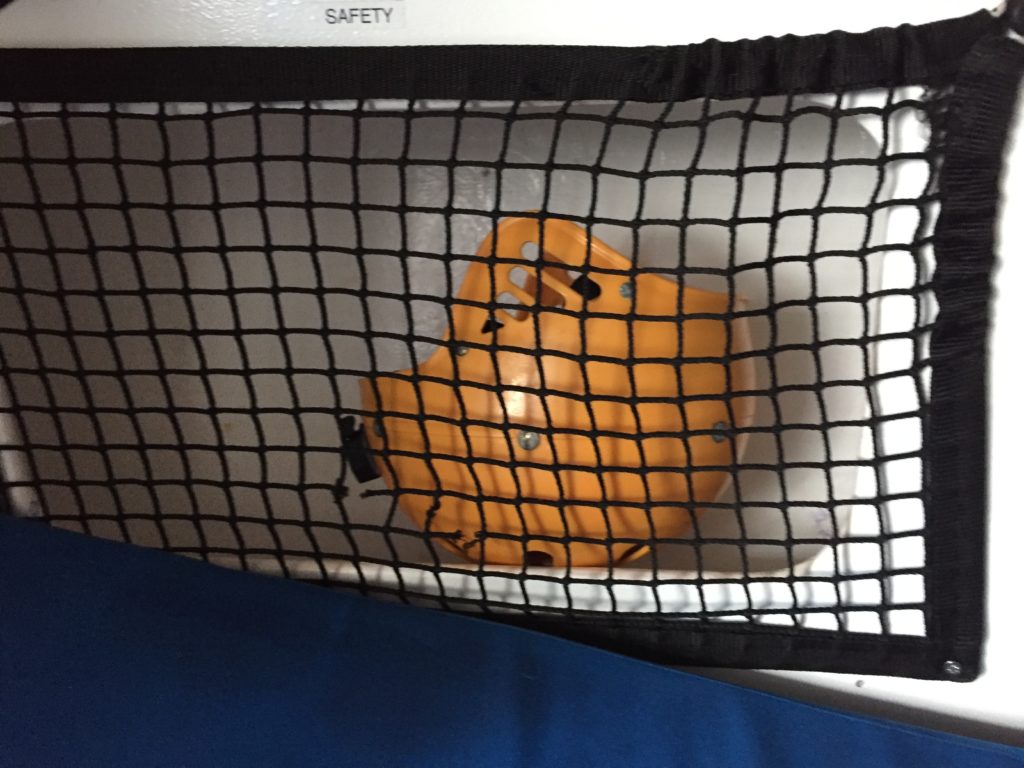
Helmets are provided.
The stanton mesh – that had previously been forward of the beam to prevent sails from being washed overboard – was being extended to the stern of her boat and indeed all Clipper Race boats including Visit Seattle. It seemed appropriate even though crew are required to be clipped to life lines when on deck at all times.
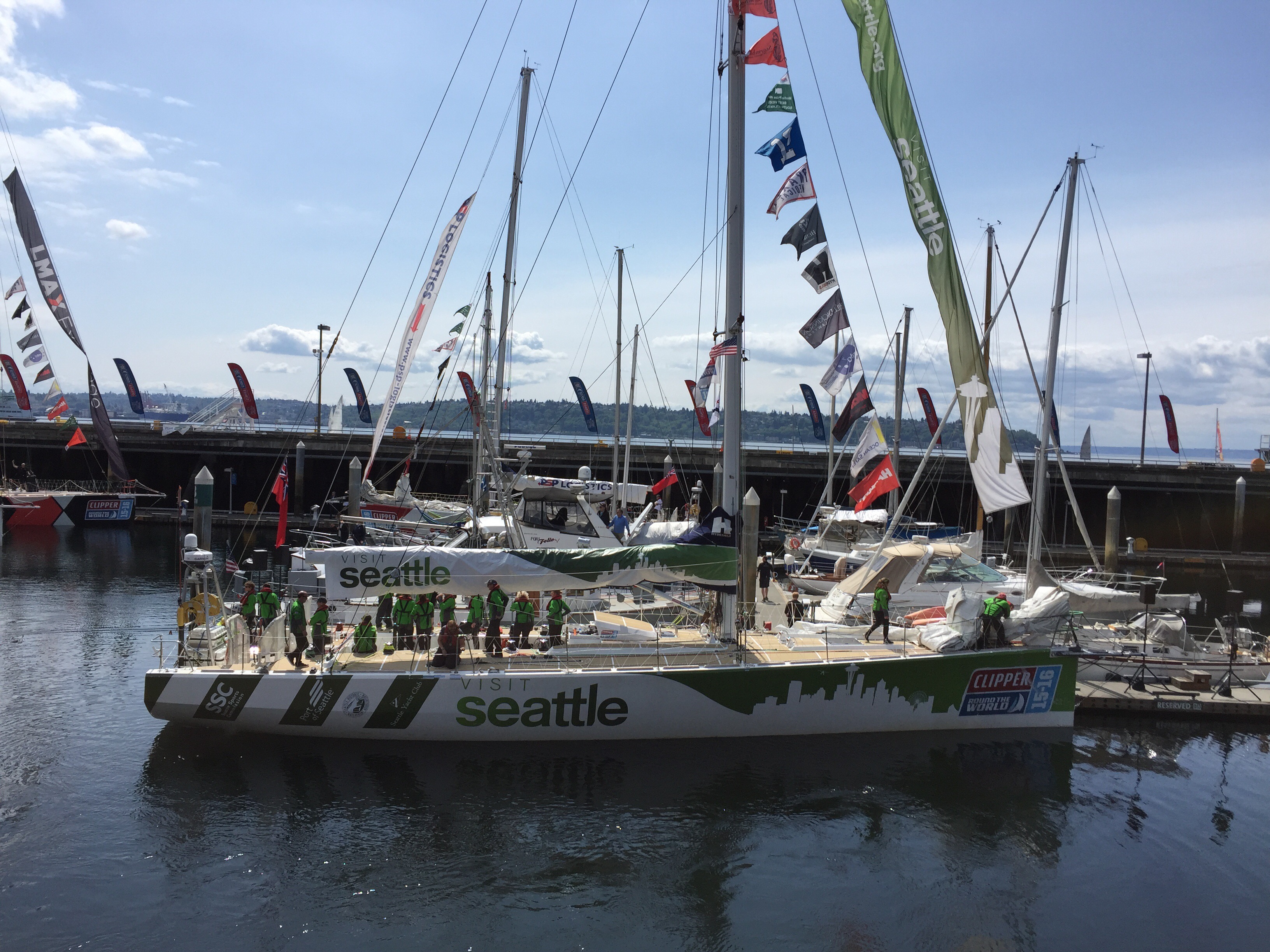
The young lady is a professional sailor, by my way of thinking. She works for a tall ship group in Europe. Nonetheless, she was required to pass four levels of proficiency before being allowed to purchase a place on board a clipper racer. The pay-to-play arrangement is common in car racing. But owing to US maritime laws, it is awkward for sailboat racing. This is because payment implies that the participant is a passenger. The US has laws restricting which boats, crews and captains can be used for transporting passengers. I have come to understand that providing a berth, food, and beer to crew who race is considered payment.
The young lady will cross an ocean again and expects to earn contracts delivering boats with her sailing resume. I ask about beer and she lights up. “Clipper Race crew are drinkers with a sailing problem.” she says. Then she waves a young man over to join our conversation. He confirms that, the night before, Clipper Race crew had spread out all over the Pike Market Brew Pub.
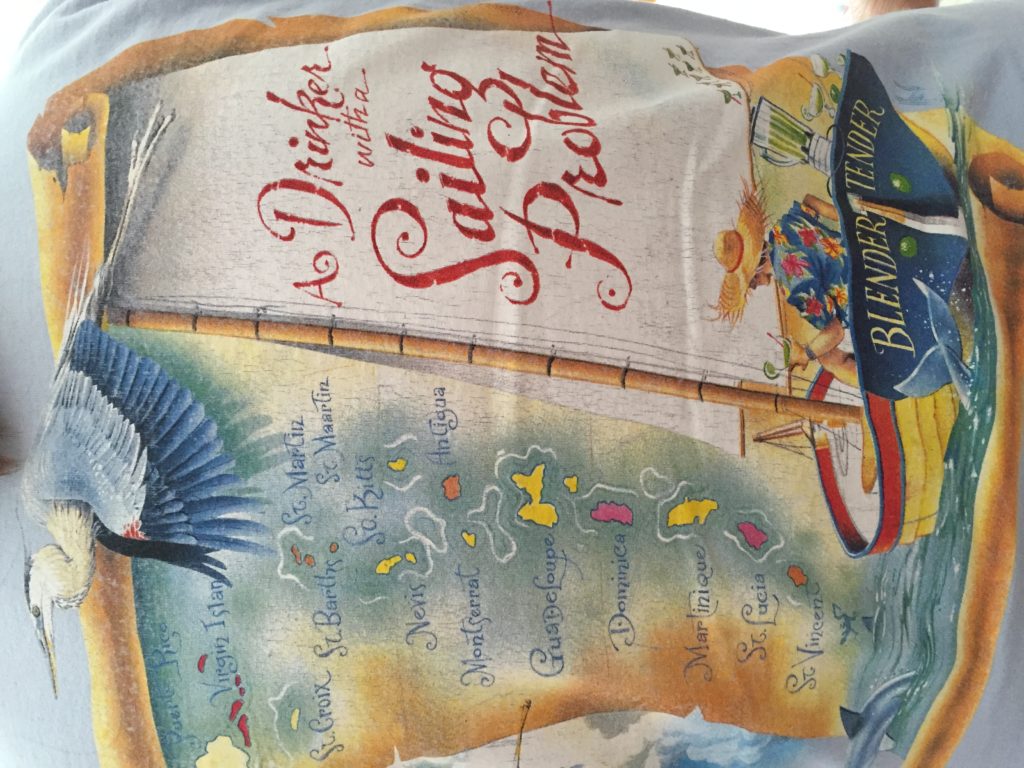
Clipper Race Souvenir Shirt from West Marine
The Pub is where the museum of American Beer can be found, and the museum had been reserved for the racers. Here you learn that there were less than 50 breweries in the United States when Knox-Johnston won the Golden Globe. Large breweries dominated world markets, including the US. They did this partially with large budget sport related marketing campaigns. Budweiser was the King of Beers and ocean racing the King of Sports. It was hard for a small beer business to compete in this monopoly-favoring business environment.
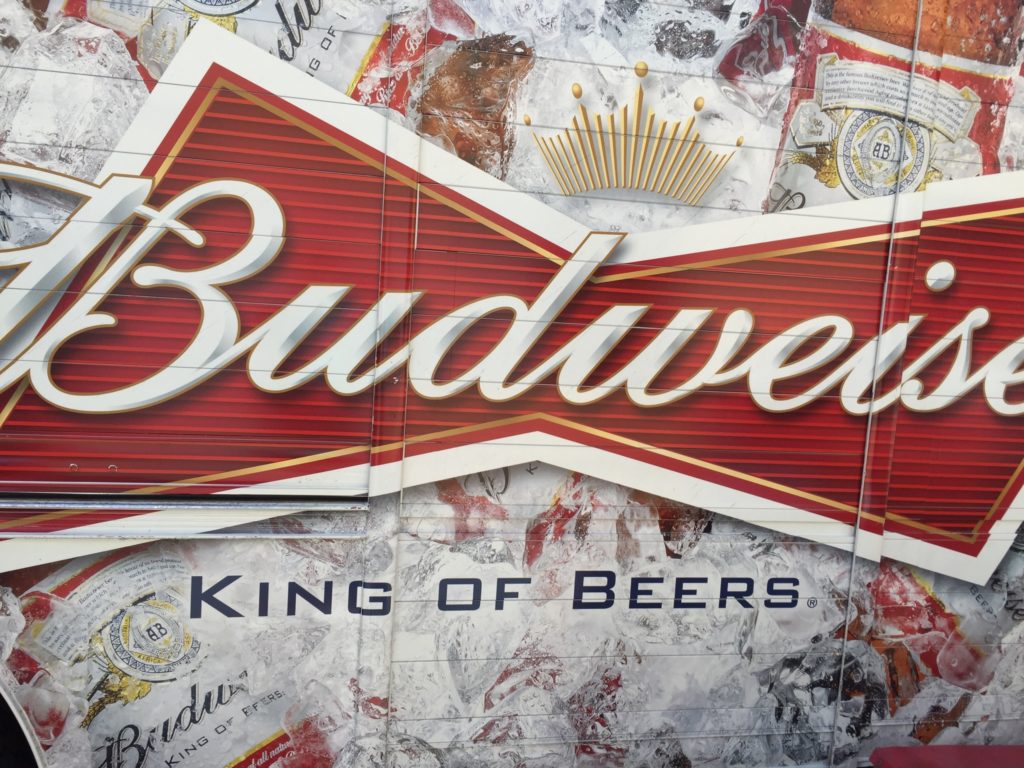
American Values do not support Kings. This is no longer American Beer.
In Seattle, it was hard for the sport of hydroplane racing. No competitor could compete fairly against the budget available for the King of Beers sponsored boat. The Miss Budweiser dynasty grew out of a handshake between Berrnie Little and August A. Busch III in the 1960s. It became one of the most successful owner/sponsorships in all of motor sports. Little became known as the King of Powerboating. Every year, until his death in 2003, the Miss Budweiser Represented the Anheuser-Busch companies all over the USA.
After Little’s death, Budweiser was persuaded to give others a chance of winning and withdrew from the sport. Unfortunately the fan base had been lost, partially owing to the predictable and repeated wins, and hydroplane racing has yet to recover. But the American beer industry did recover when laws were passed restricting advertising.
We learn at the museum that the first American micro brewery was started in Yakima Washington and the second in Seattle. Executives at the King of Beers purchased the second (Red Hook). All of Seattle mourned. It was like the Boston Tea Party after the King of England was (most likely) bribed to allow the British East India Trading Company to directly supply tea to the colonies. Bribes for concessions to rulers had led to complete East India Company control of India at the time America was colonized. Business men in the American British colonies knew it was impossible for local colonist tea importers to compete against the monopoly and had ensured before starting colonial businesses that that would not happen. English laws prevented East India Trading Company from serving British colonies directly. The East India Trading Company was required to first sell and deliver tea to England and pay about a 25% tax. Its direct transport to the American Colonies (without colony representation and without tax) promoted the Samuel Adams political protest known as the Boston Tea Party. Fortunately, the purchase of craft brewery Red Hook only encouraged more micro brew businesses. So AB Inbev does not control the Seattle Beer market. Instead the market is like the wine market. There are tastings an even the Beer Week event.
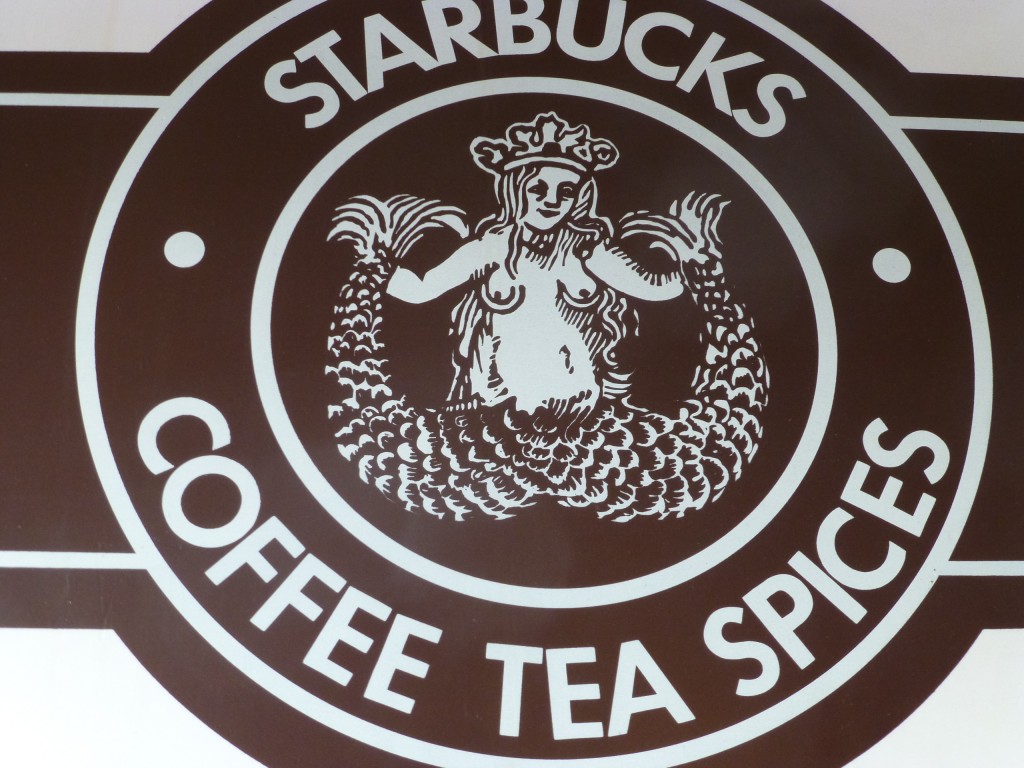
Original Starbucks Logo still at its first location (Pikes Place Market)
AB IbBev resently obtained control off the bottled tea at Starbucks coffee shops where they supply or will soon exclusively supply bottled tea. Seattle Beer Week enthusiasts are worried that Starbucks will eventually serve not just coffee and AB InBev bottled tea but eventually Red Hook and the recently purchased craft brew Elysian or Coors, Miller or Molson’s Beer. These brands are all owned by AB InBev. This story is ongoing and important. But the story of American Beer did not resonate much with Clipper Race drinkers who left pike place market brewery at 2 AM according to the young man.
The young lady tells me that some clipper race participants find marriage partners on competitor boats or at reunions years later. Couples are not allowed to race on the same boat. Even so, some do it again, perhaps on different legs or on different years and they do so into their 70s.
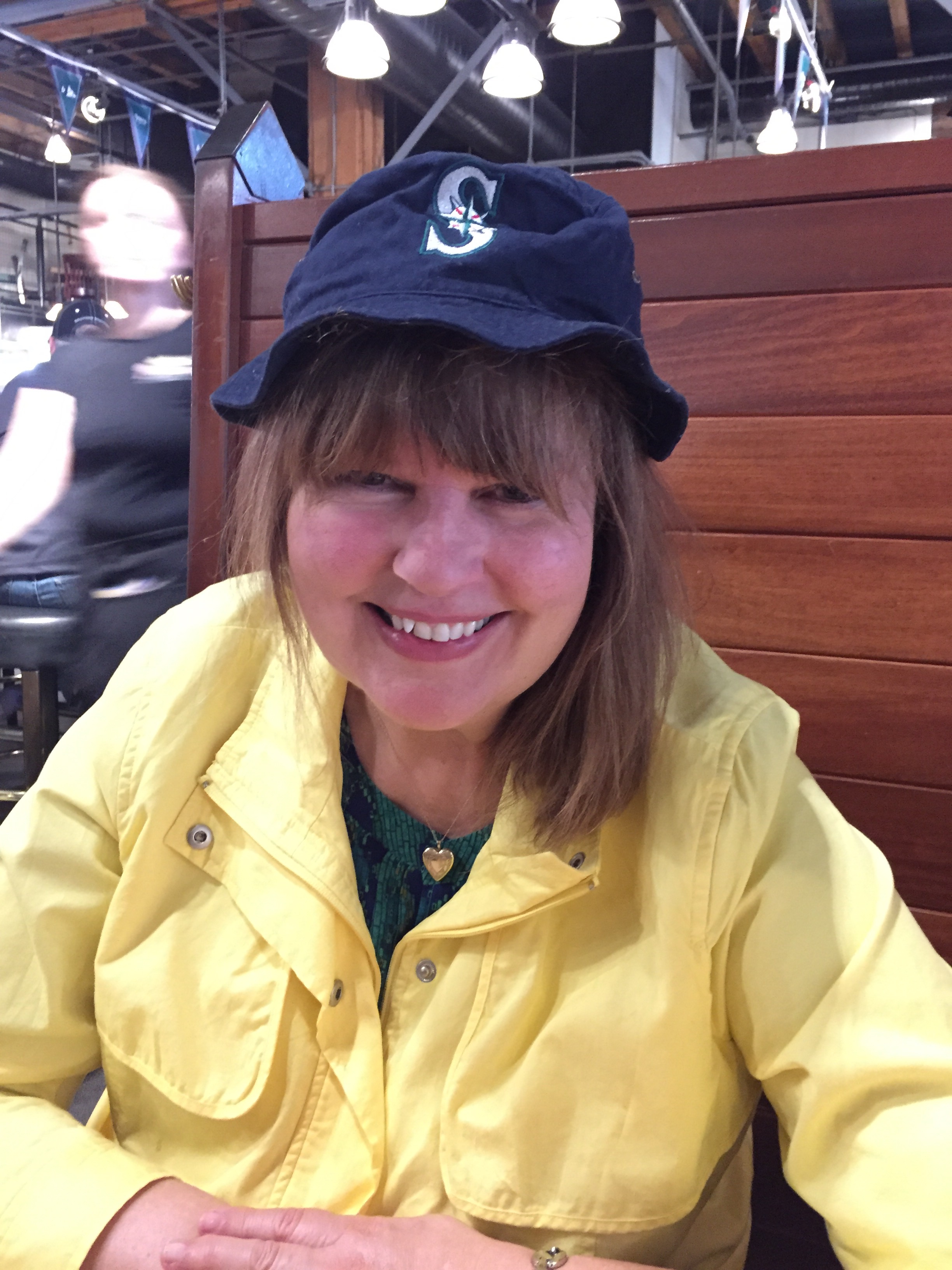
Clipper adventurers are in a club. They meet not only on the docks and pubs but also at sporting events. In Seattle my wife and I join them for a Mariner Base Ball game. Hew, Captain of the Visit Seattle boat, gets the opening pitch over home plate. We enjoy video of the Clipper Race boats on the huge right field screen. It is clear that few US citizens have done a clipper race because a discussion about when a baseball player gets to run around all the bases goes on and on for at least as long as it takes to drink a 20 ounce can of Coors beer. Home Run is the answer. In 20 years perhaps 5 adventurers have clipper raced from the Pacific Northwest. The two I know of would do it again.
There is time for discussion in between baseball action. This is one of the great things about the sport. So I am able to talk about sailing with the couple in the seats in front of us. He would not do it at all. She was a 470 Olympian and it was “in her DNA”.
470 dinghy sailing is a wet sport that until recently wasn’t much like ocean racing. Now ocean race boats are like dinghies in that they plane down waves and through waves and hence, even on a clear good sailing day, are wet rides. She had to complete the four levels of training, just like everyone. She had also signed a contract which would prevent her from spending much time with her husband, in port, in between legs. The contract required her to crew during demonstration sails. He was considering parking an auto at the port for her to use for visiting as scheduling permitted. She confided that she had not fully thought out the lack of contact with family members that is usual while ocean racing. The hope was that an expensive satellite phone/ text option would make things easier. You pay 150 pounds up front per month and a fee on both ends of the transmission. Because of power consumption, communications are scheduled through the race boat’s Captain. We all sing during the seventh inning stretch. The beer monger realized that he was barking to sophisticated drinkers so he yells “Who wants more American Swill.” We all laugh.
The joke is a good one because the U.S. Beer market is part of a global domination that also includes expansion into developing markets, especially Africa and Latin America. $106 billion had been paid in October 2015 by AB InBev to control the swill served at our Mariners game. AB InBev earlier had purchased The King of Beers, for a time continuing to market it as American lager. Neither Coors nor Budweiser are currently US beers.
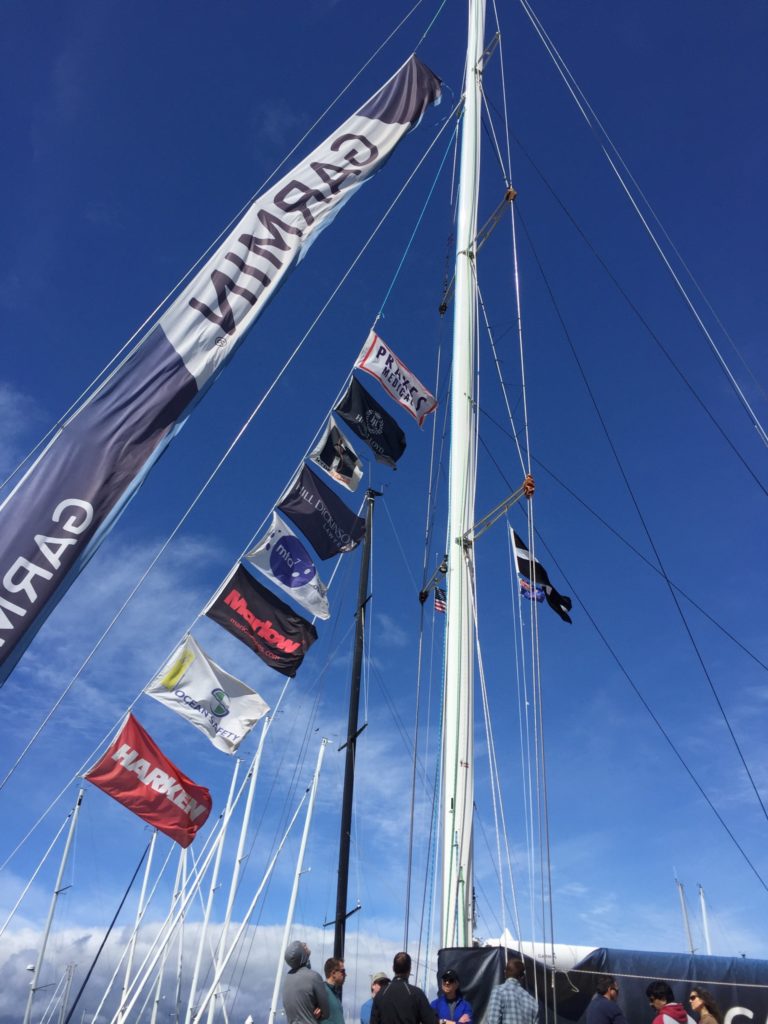
At Shilshole Marina, several clipper race boats are being repaired. Corinthian Yacht Club and the sailing school had made arraignments for visitors to tour Garmin. Garmin, like Visit Seattle had lost her carbon fiber bow sprit. Here a family reunion had been organized for a circumnavigator.

Father discussing son’s circumnavigation
The flag of the circumnavigator’s father (flag of Cornwall) was properly flown on the port and not starboard haul yard were the US flag is to be flown as a courtesy by vessels from other countries, such as Garmin. The father had moved from England to Oregon where his son was born. After learning this, I asked the father if he was a US Citizen. He was and noted that “everyone would desire to retire in the US, if it were not for two things. US gun laws, and health care coverage.” He had made his peace with those two deficiencies and had little desire to retire elsewhere. There was no concern regarding the US presidential candidates. He was aware that a petition forbidding one of the candidates from setting foot on English soil had been taken up by parliament a few weeks earlier. He encourages me to chat with his son.
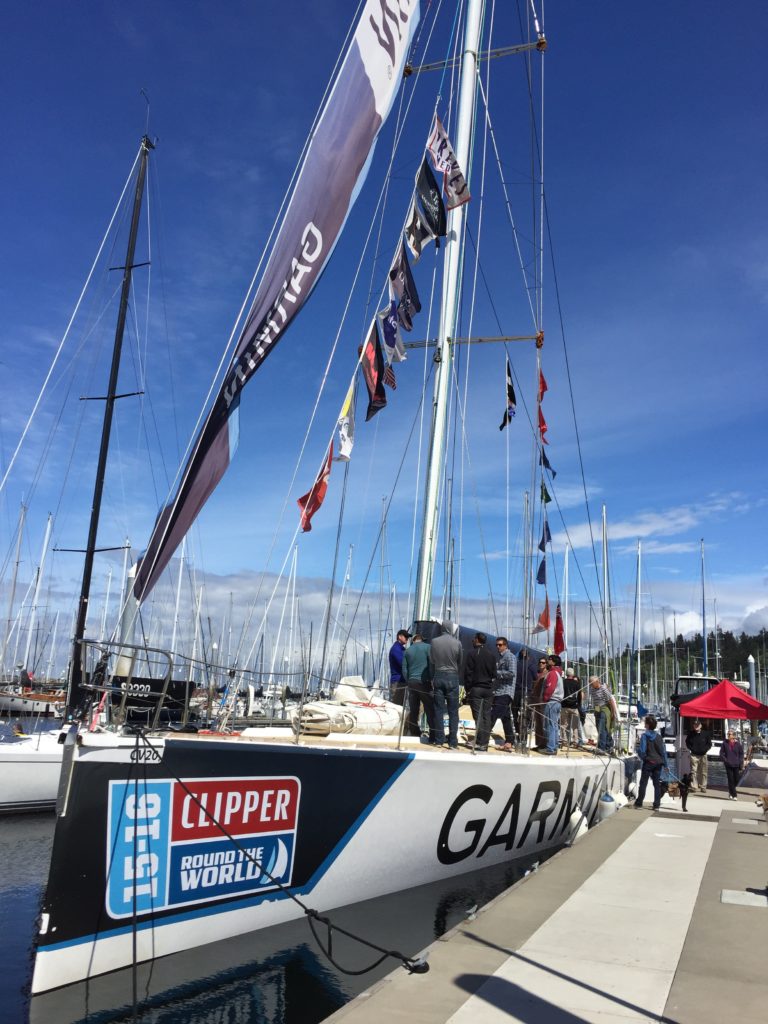
Carbon Fiber Bow Sprits were ripped off during North Pacific crossing.
The North Pacific leg of the race had been a hard one. Not only had three race boats lost sprits, but there had been a knockdown where the helms person had survived after being squashed under a wheel tower. This was in addition to the sailor swept overboard to her death owing to not clipping in. I ask if his son would do it again and am told his family hopes not, and that they think not.
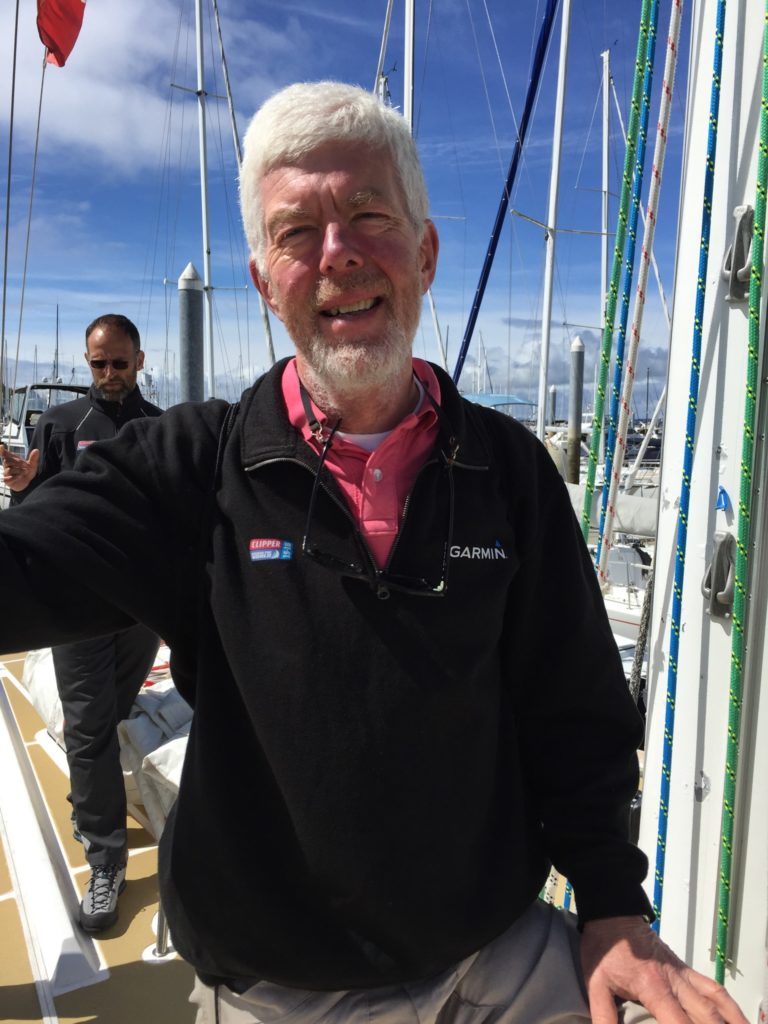
After two Océan crossings, Bill Longley Cook would not do it again.
A crew member speaks up. “ I would not do it again.” After completing a leg of the race, he asked about the North Pacific leg and was told that only crazy ones do such a thing. But he was also told that since he had asked he would regret not trying. Clearly he had past some kind of a test, in his first leg .. or in the asking. He says his family had purchased a dry suit to assist him in the North Pacific leg. They had been concerned. Unless you are a circumnavigator, you are responsible for all the gear. But you must not bring more that 20 kilograms. That includes boots! I ask, if in lieu of beer, drugs like aspirin are allowed as personal gear. They are, subject to captain approval and the weight limit. Crew was not allowed to bring Tsingtao Beer from Qingdao. We import Tsingtao to Seattle but only the Tsingtao Beer bottled in Qingdao is brewed with mineral water from the Laoshan Spring. Since the “King of Beers” monopoly took over the brand, reference to the Spring had been removed from bottle labels. It is featured in the 1982 film Blade Runner. By 2010, Anheuser-Bush InBev had sold all its interest in Tsingtao. Qingdao, which is known world wide for the beer, has sponsored Clipper racing for 12 years. Clipper Racers get to enjoy draft Tsingtao before crossing. If only the race boats could bring kegs to Seattle. Seattle Beer Week folks could deploy the kegs assuming they remained untapped. The Week extravaganza is scheduled shortly after the Seattle race village closes and the boats head for Panama.

The crew member describes how his race boat was damaged after leaving Qingdao. The asymmetric spinnaker had dragged in a wave becoming like an anchor and twisting the bow around. It was too much for the carbon fiber bow sprit which shattered. Those doing it again looked forward to a mettle sprit. The “three old GOAT group of 60 year olds quickly cleared the forward decks and saved the sail. GOAT in boxing means Greatest Of All Time. . We check the mast. It is aluminum. Not carbon fiber like other ocean race boats, which of course avoid the North Pacific. They do however go around the horn.
It was the route to the horn where Chichester with his keg of beer expected capsize and reinforced the rigging. Clipper race organizers do not route a leg around the horn but the boats are more worthy of doing so than the carbon fiber Volvo Ocean race boats. The editor of my local sailing monthly wrote that the Clipper Boats are overbuilt. I was testing that statement, and finding it questionable. When VOR boat Vestas Wind hit a reef, the hull splintered. Only a small portion of the deck was worthy of salvaging.
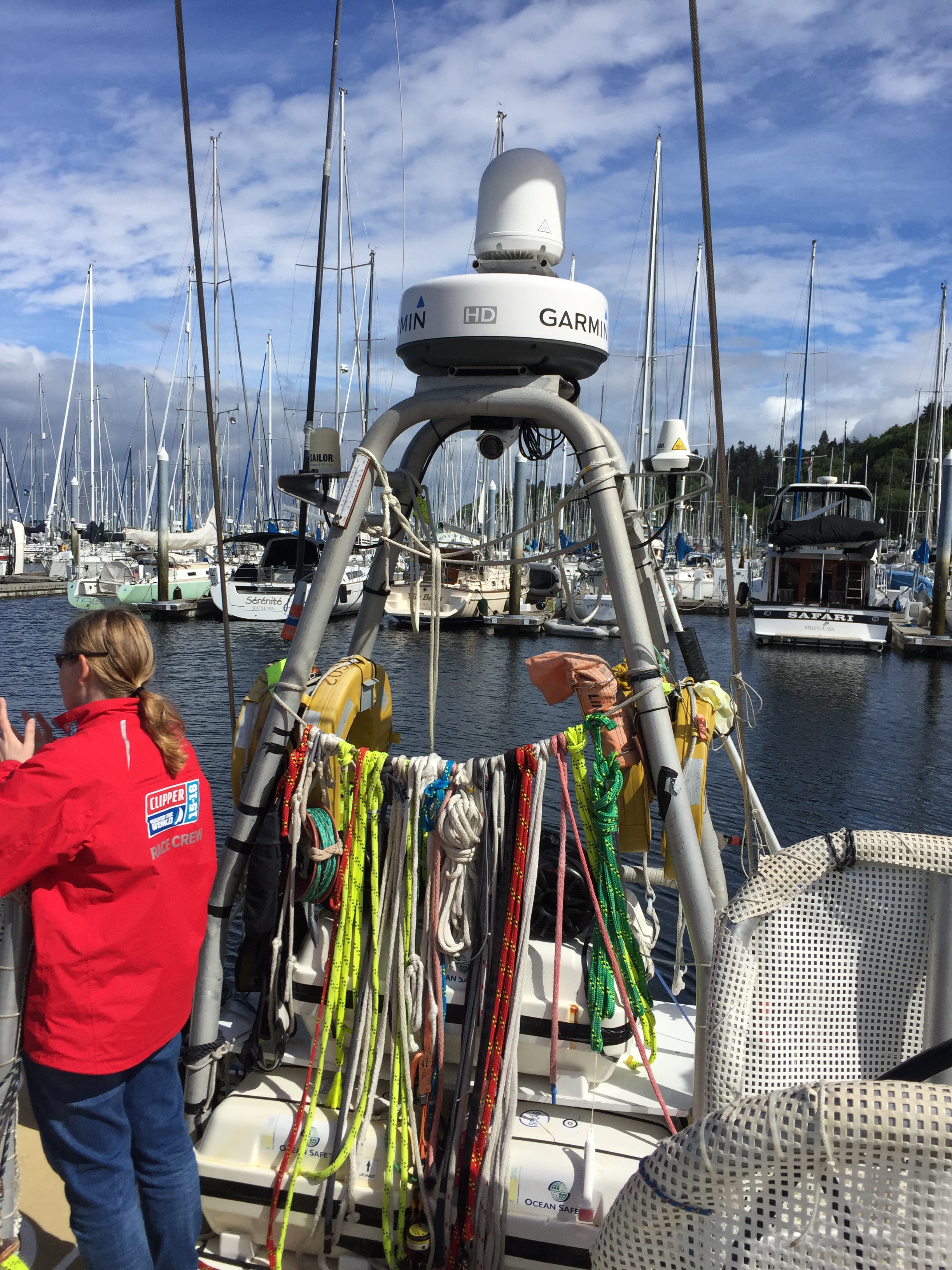
The circumnavigator is available and we discuss Garmin electronics and satellite phones. He is responsible for coordinating satellite phone/ texting. No photographs can be attached and text is typed by himself. A generator runs for six hours at least each day to charge equipment and make water. I ask about some Scuttlebutt. On the Route to Qingdao, China (where the clipper 70s were built), race leaders were way ahead of schedule and race management added to the course distance so that, I had come to believe, arrival would coincide with race village preparations. More than one crew member was upset about that. Satellite phone/ texting, while screened, would have been allowed.
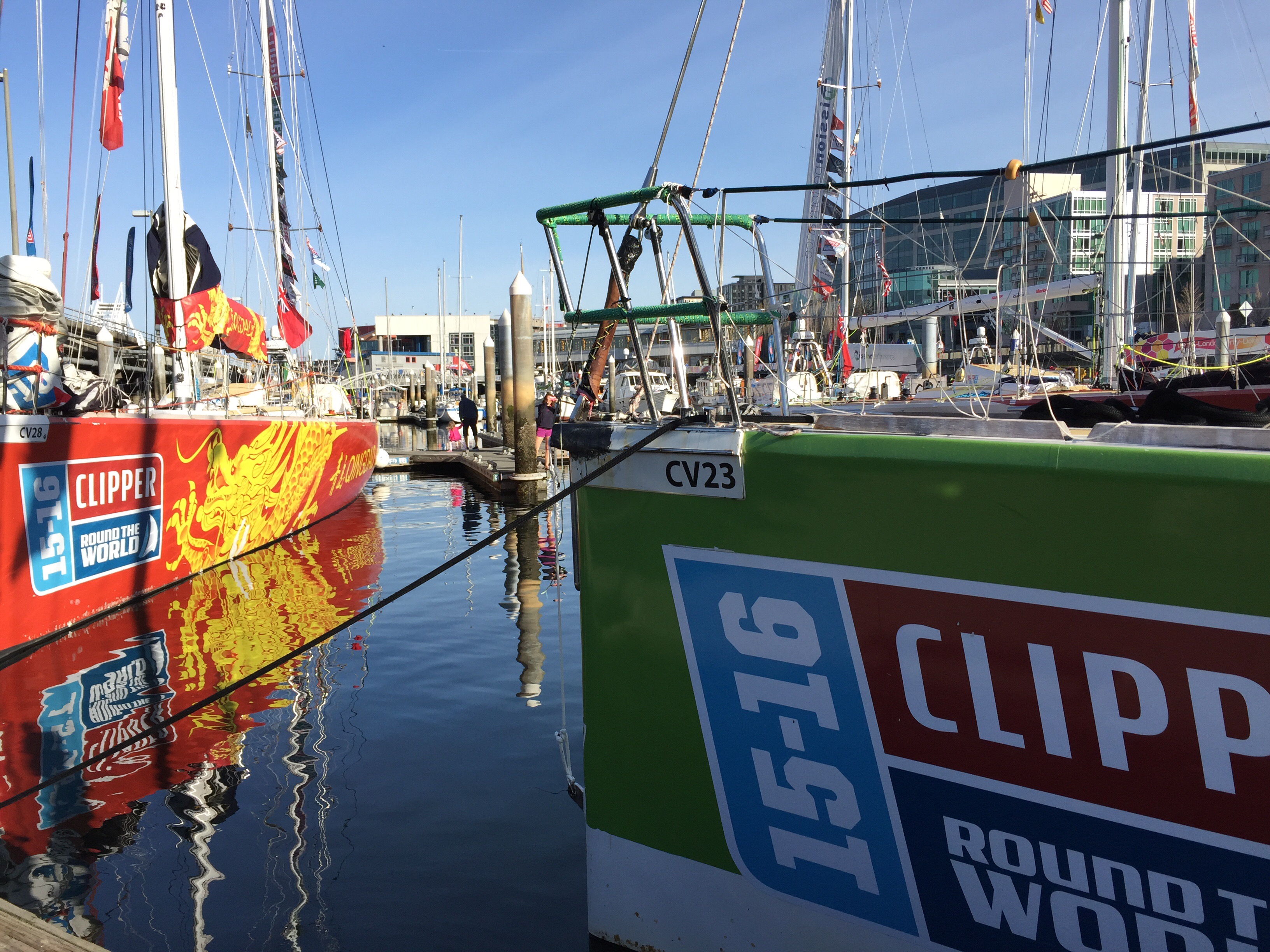
Later I come to understand that visas for race crew cover set starting and ending time frames. Legalities may have been the primary reason for extension of the race course, which delayed arrival to the visa time frame. The race was also extended on the later Derry-Londonderry leg. I know that crew have cell phones and contacted friends to coordinate arrival in Seattle as soon as they were in range. Contact with Canadians prompted a delivery of taisty food (but not beer) items to race boats at the leg finish line.
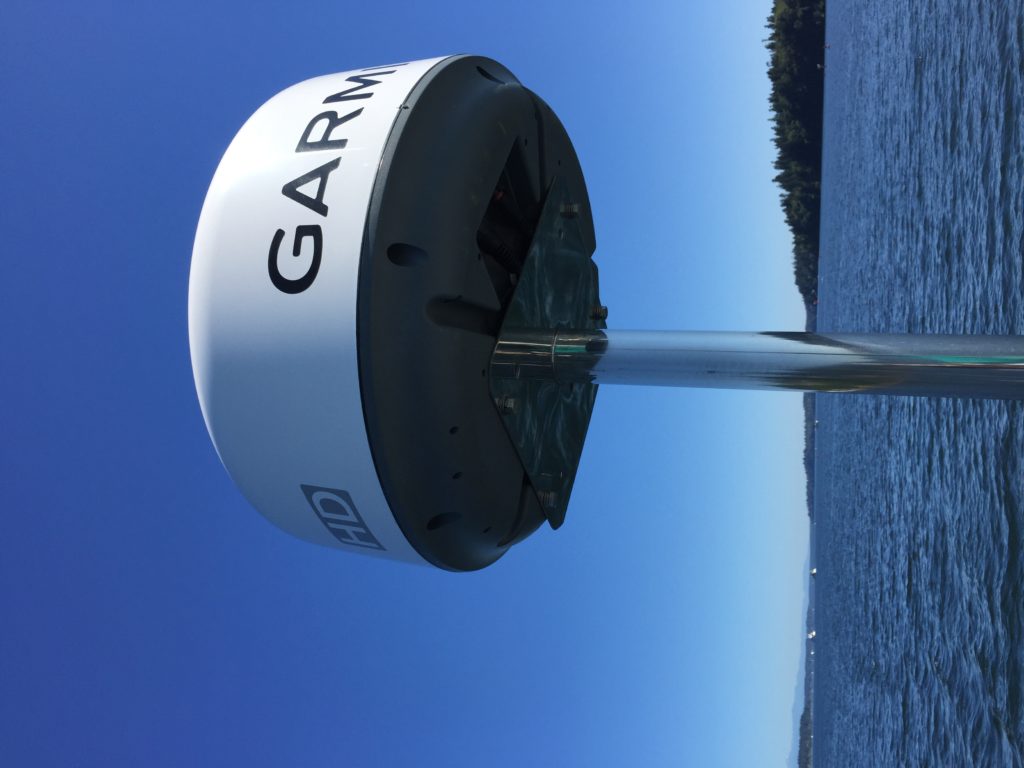
Clipper Race like electronics on Murrelet installed by Blue Water Yachts
The electronics on a clipper race boat are not unlike those on cruising sailboats, where cell/ satellite phones can be used almost at any time and place. But these endeavors are not a cruises. They are serious races. The circumnavigator will complete his circumnavigation but will not cross an ocean in a sailboat after that. Instead he will write novels about ghosts from a home in Oregon. I press him and he says that for 5 million dollars he would do it again and then conclude that it is stress put on his family that is the major risk to be compensated for.
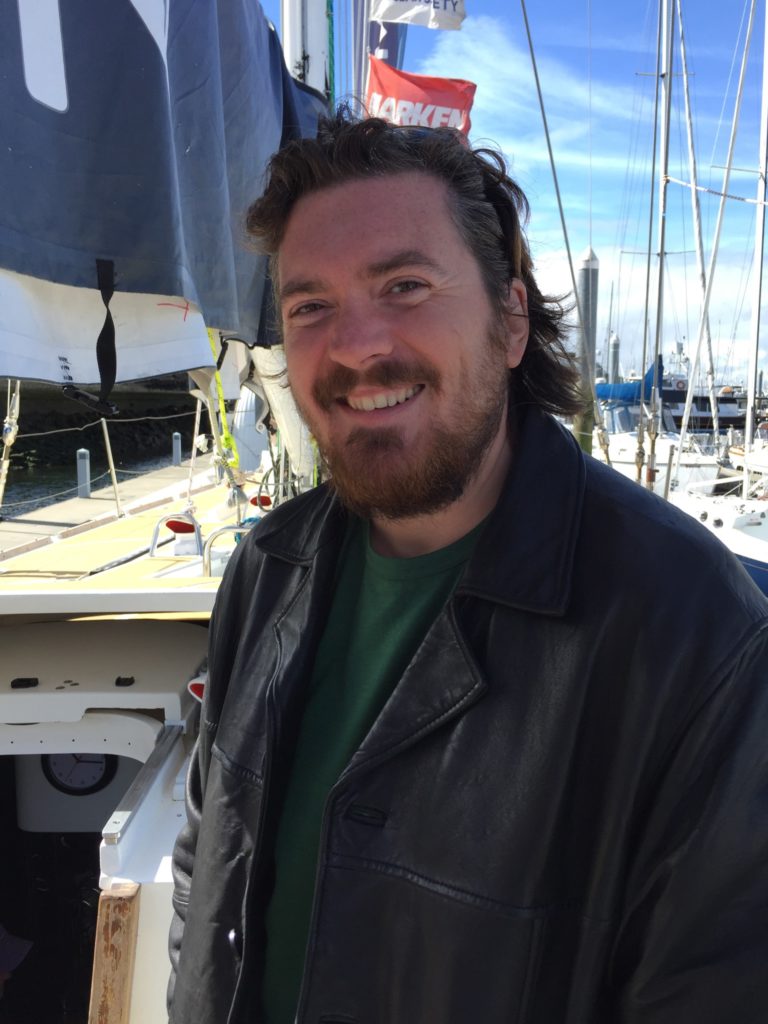
Rich Perkin will complete circumnavigation but would not cross an ocean again without pay
Clipper race crew do not take on financial risk in racing. Health and Life insurance, boots, gloves and foul weather gear are his or her responsibility. Food and housing on board are provided. Beer on the dock at arrival is provided. Saftey Equipment is provided. It is an adventure like mountain climbing.
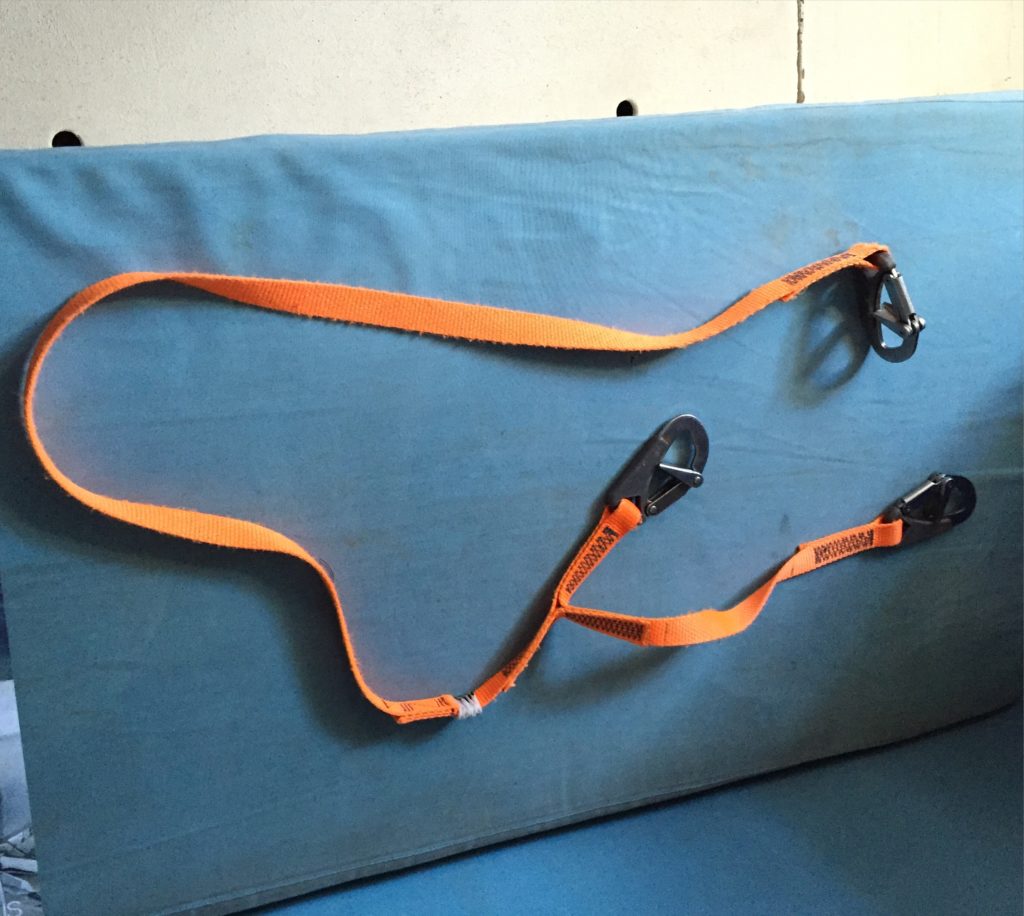
The tether is designed for clipper 70 life jackets and so that you can clip in without ever being unclipped.
On race day, a school teacher who completed the North Atlantic leg on Danang Vetnam compared the endeavor to mountain climbing. Her boat was always heeled. They go faster at over 20 degrees heel. So there is plenty of climbing up one side and then down again. Most Ocean race boats have water ballast that can be pumped from side to side and for and aft and out of the boat to get the optimal heel and stability for speed. Some, like Vestas Wind, have fin keels that can be swung from side to side to heel the vessel.
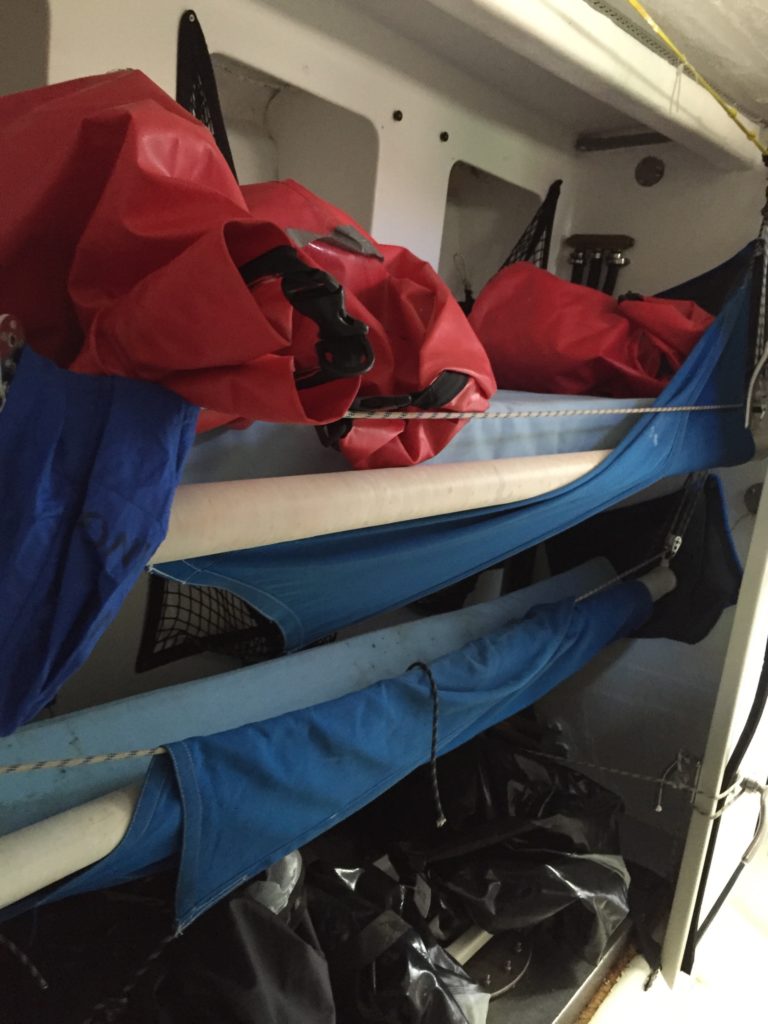
Bunks used only on high side. Lee cloth prevented tumble during knock downs
On clipper race boats crew substitute for water ballast and canting keels. The school teacher explains that even though there are enough bunks for all, every one shares. This is because her captain requires crew to sleep on the high side. Crew also must move their 20 kilograms of personal gear to the high side as well as any movable ship equipment. So no one gets their own locker.
If there was a keg of Tsingtao beer aboard, it would be shifted from the low to high side serving like water ballast. It may also be moved forward to get the fat aft end of the sail boat lifted. All this reduces wetted service area which is a source of drag, which slows the boat down. The shifting of the keg would have helped make the race boat go faster. In fact, merchant sailors making the same run time and again would shift water and rum and beer barrels in a similar way to gain speed. Speed was important to a merchant sailor, in comparison to duty on a fishing schooner or whaler where the catch might swim to the boat rather than wait at a fixed point.
The school teacher tells me that crew dynamics are the hardest part of a Clipper Race and I question her on that point. She had hoped for more male crew members on Visit Vietnam. This wasn’t just for assistance moving gear to the top of the mountain and back but also to help mediate. At one point, a crew member expressed the desire to change race boats because of a lack of “spirit”. He was talking about competitive spirit, a desire to win. His crew members, he had determined, had lost the desire to win. This was before Danang Vietnam broached and was knocked down twice, pinning the number-two helms person and sustaining damage that destroyed even the desire to finish.
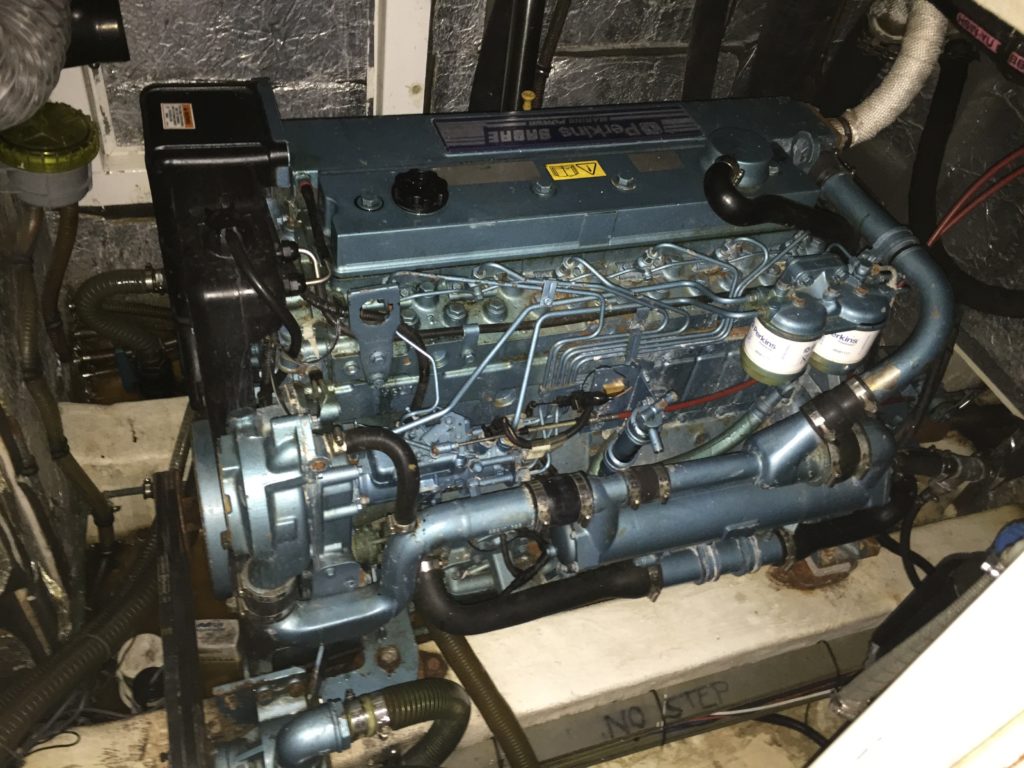
Secondary means of pulpulsion, the first saftey item on a modern sailboat is the engine.
The Clipper 70 boats were designed by a person known for his Blue Water line of cruising sailboats. A cruising sailboat that size will store enough fuel for a thousand nautical miles and will have a substantial engine, powerful enough to head the out of control vessel into wind so that sails can be dropped. The same capability was built into the Clipper 70 race boats. I think of engines as the most important safety feature. When The Puma VOR race boat shattered its carbon fiber mast, it could not motor to land because she carried only a small amount of fuel. (Enough for about 100 nm.) Unlike Clipper Race boat aluminum masts, which bend rather than shatter when failing, jurry rigging Puma for sail was not tried. The crew had to be rescued, like a multihull after capsize. The boat was salvaged by motoring to a rescue boat which was capable of towing. Danang Vietnalm, abandoned racing and motored to land, but could have sailed and did not require a rescue boat.
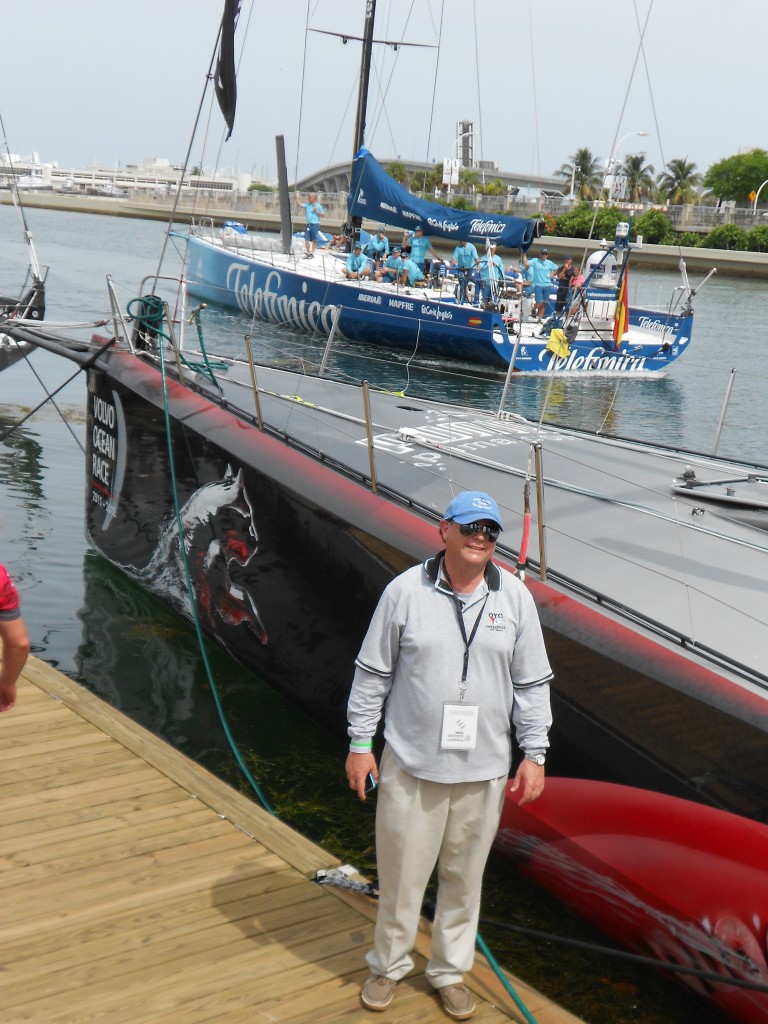
All Carbon Volvo Océan 70 Race boats were underbuilt for a North Pacific Ocean crossing.
The school teacher wants the chance to do it again. She lives in the interior of Australia and belongs to a fresh water yacht club where news from her salt water adventures are greatly desired. Eventually she would like to sail around Australia. There is a clipper race leg that covers perhaps one half of her goal. She expands on crew dynamics.
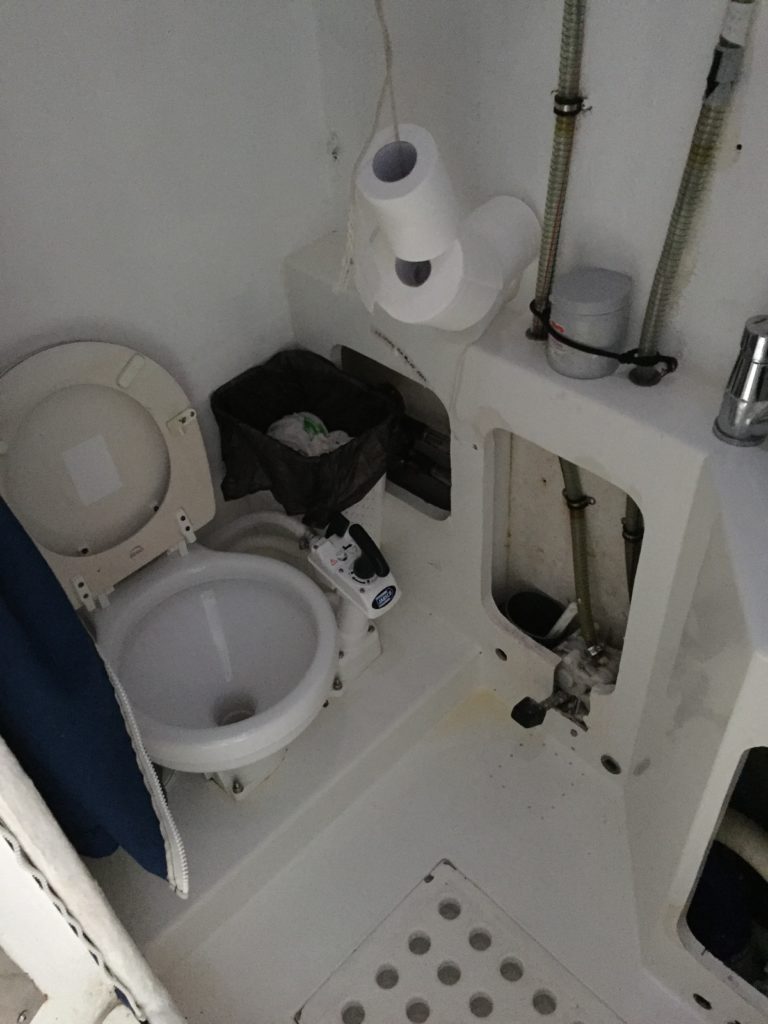
Crew Dynamics is the biggest problem on any boat. Captains often clean heads rather than deal with the dynamics.
Being slow to move through the companionway was something others git snippy about.
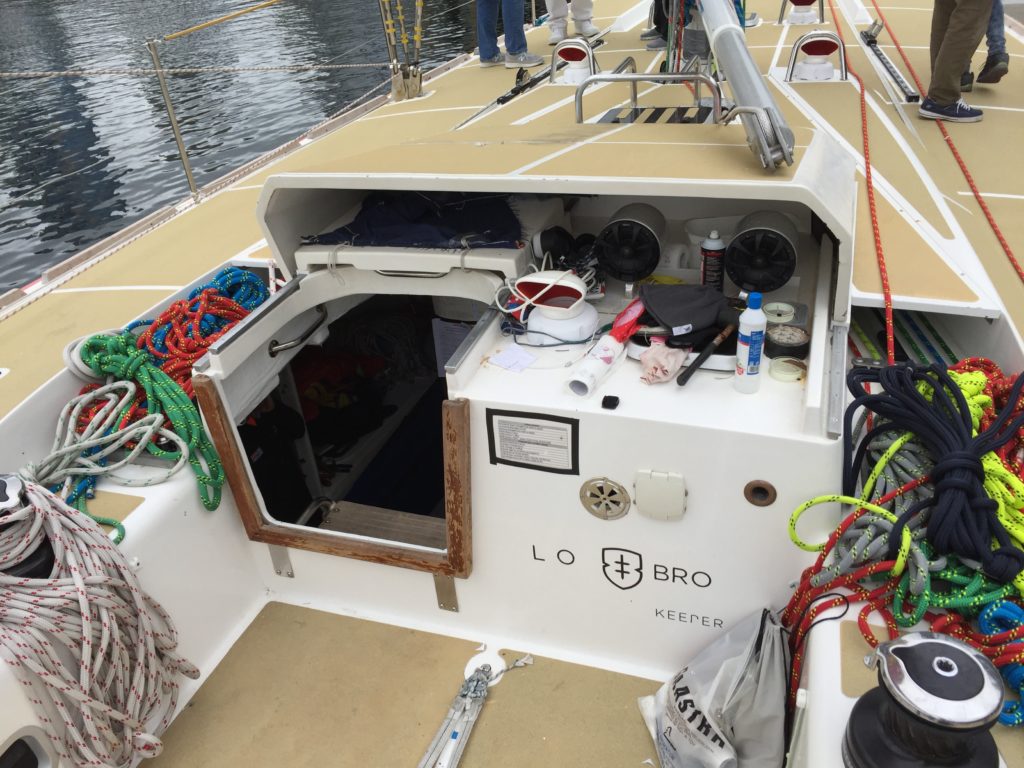
Small companion way frustrated crew when blocked by slow mover.
Drying socks over someone’s bunk would bother anyone but moving any personal item without permission might be worse. Taking a shower would cause resentment, even with the ample fresh water maker supply. This is because it takes time from other activities including important sleep time. Sleep deprived crew are more susceptible to sea sickness. A sea sick crew member can lead others to also be sea sick, in sympathy. Sea sick sailors, even when functionally competent, can not be expected to have race spirit. Some Captains chose to serve as arbitrator but hers preferred that crew work things out on their own. But why would they? Instead they might wonder if they are putting in more effort than other crew members and worry about team spirit.

Hatch above navigation station is not available for crew.
I had asked Johnston if crew members wore biometric devices. He said several companies had approached him about that. I know that Garmin is a sponsor marketing that kind of thing. The notion is that the number of steps, trips up the high side, amount of heart pounding grinding, miles run on deck, hours slept, things like that, could be gathered by the on board medic for presentation to crew members. Many cell phones and watches can provide some of that. Crew might be able to work things out with the information. Perhaps crew spirit would be improved in the same way friends use Fitbit to encourage each other to work out more. Johnston wasn’t keen on the idea. But there are at least three Captains with backgrounds or training in computer science. It could happen. Johnston mentions that each boat has a designated medic and that this had reduce the cost of clipper race insurance.
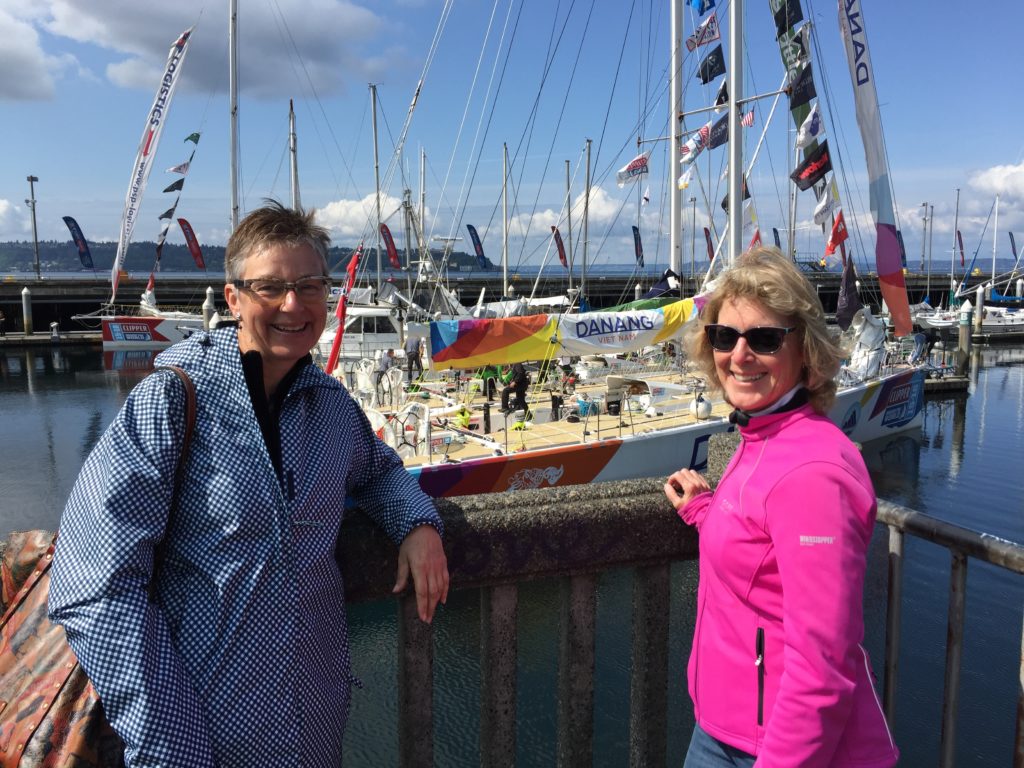
Linda Drange discussing crew dynamics with cycling mother of new IchorCoal team member.
The school teacher waves goodby to her friends on Danang Vietnam. After satisfying US customs, her passport had been moved from where she put it on deck. She can not wait for boats to depart for the starting leg for the sail to Panama. She must fly to San Francisco to deal with the lost passport issue. Port Authorities and the Coast Guard have to assume that the documentation is being used by terrorists.
Johnston, who is from Northern Ireland, had remarked to me that everyone hopes the terrorist activity in his country was over. He counts the years at 7 since the Irish Republican Army put down arms, then tells a story about a Catholic priest terrorist. It is hard to support organized religion when it is linked to terrorism. Johnston doesn’t do so. I think about the King of England who broke from the Catholic Church, the Protestants and Muslims, and services for sailors who are buried at sea. The latter was likely on Johnston’s mind when we chatted. Later I learn that a Muslim had been elected mayor of London.
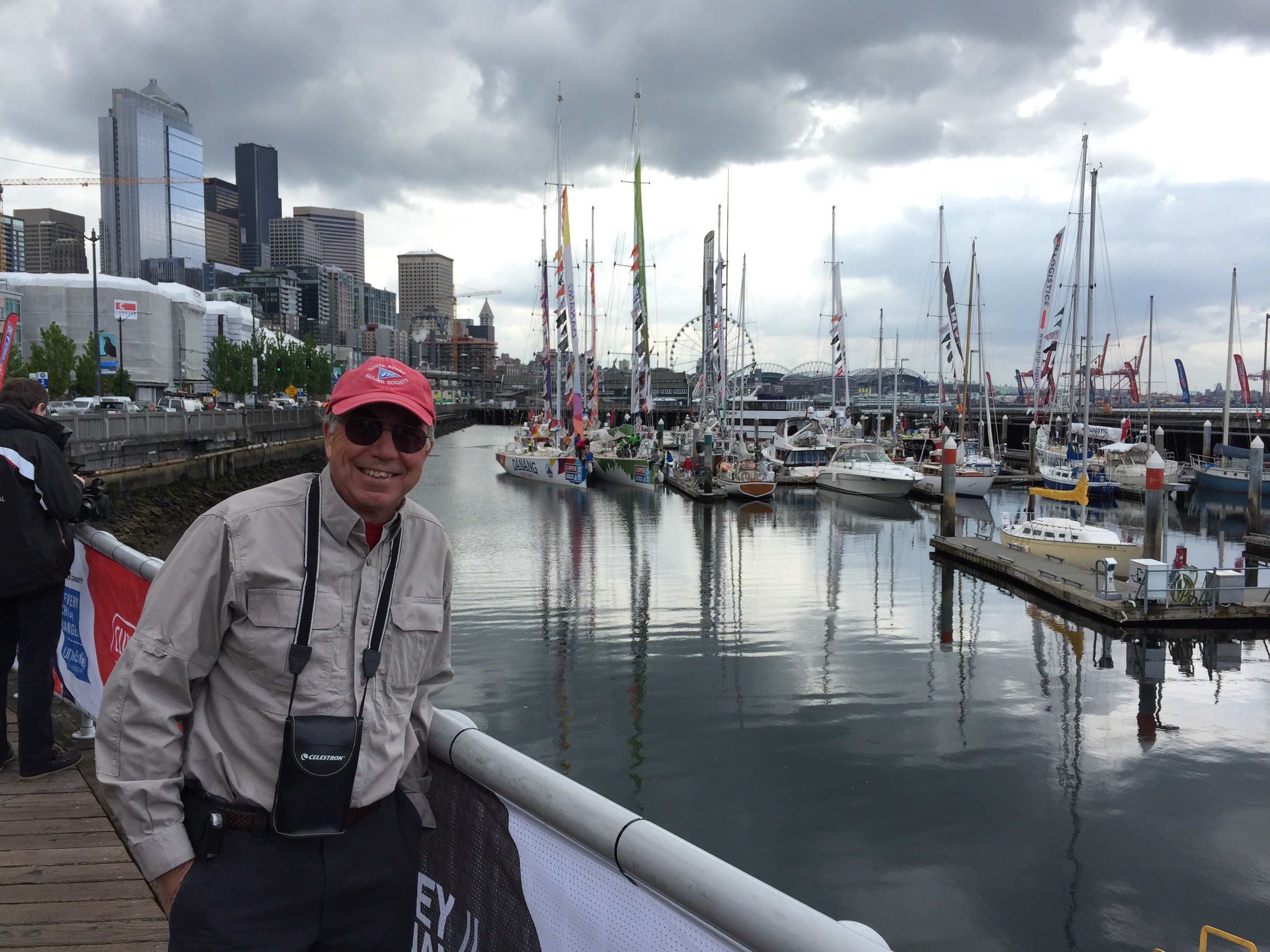
The past commodore of my sailing society, a Vietnam Veteran, is with me and sees that a compass is being mounted on Danang Vietnam. He is rooting for that crew. Recently retired from a career in the military, he may follow another career military friend and cross oceans in a sailboat. I think it is great that he is interested in the Clipper Race venture. The Clipper race boats, unlike the Volvo Océan Race boats, actually sail around the world. The VOR boats are transported on armed barges in areas where pirates may intercept. (This will not be the case in 2017 if the VOR is run as the legs have been changed to avoid pirate areas in the Indian Ocean.)
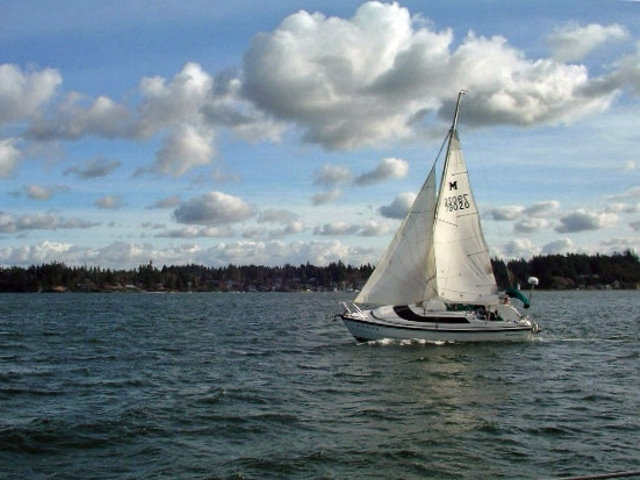
“Murrelet” in Hope Island Race.
In the Salish Sea (where Seattle is located) we race our boats, or crew on OPBs (other people’s boats), year long and have noticed that instrument pods on new boats can be removed when the boat is docked. It is a way to prevent pilfering. The pod is mounted where the helms person can see it. He wonders if the compass was removed to prevent it from being stolen.
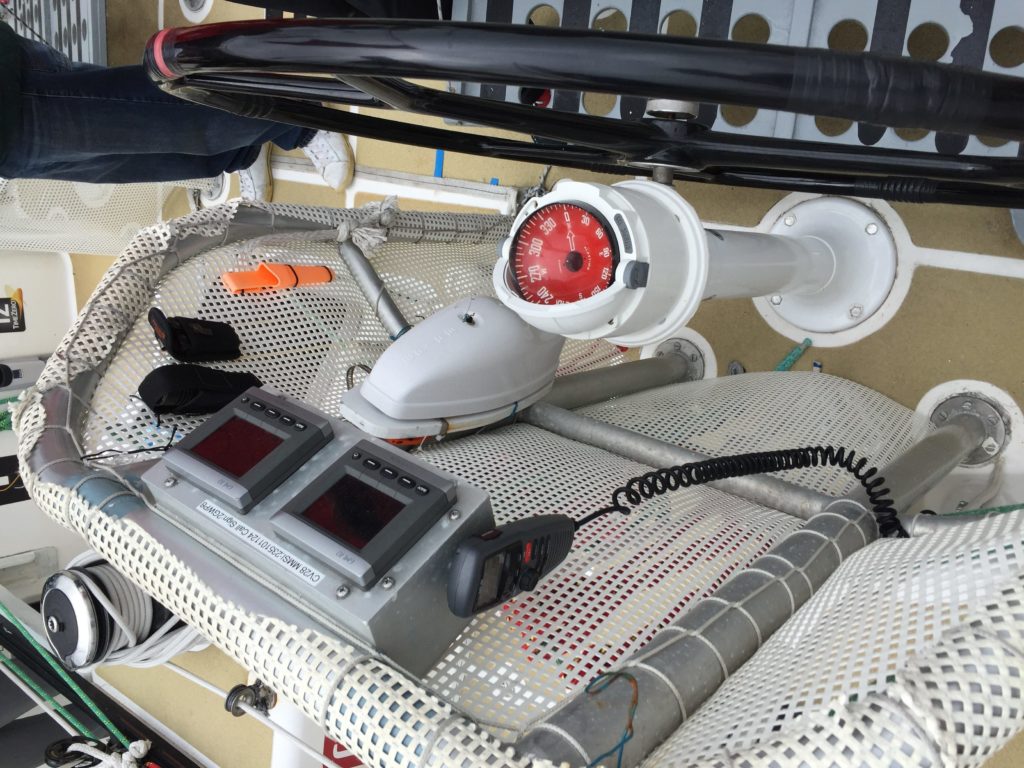
Instruments
Splash from crashing through waves will damage electronics. Cruising sailboats will slow down or change course to avoid some of the splashing – but not race boats. Paper charts are also present. The navigator lifts a hatch to convey information regarding coarse and speed. The compass had been removed or replaced because of knockdown damage.
Our society follows US Sailing rules and a magnetic compass is required for steerage at sea. If one is not aboard there is a risk of disqualification should a protest be filed. Possibly owing to terrorist threat but also related to man overboard recovery we were recently requred to update our radios. The mounted radios connect with handhelds and with GPS equipment. All are registered so that other race boats and Home Land Security can monitor. The Clipper boat races follow Word Sailing (ISAF) rules. World Sailing is the final arbiter of protests by clubs such as ours who follow US Sailing. This connects us to Clipper Race crew. But we are also connected by the recent loss of a crew member from one of our own racing boats. He was an experienced sailor coaching our most accomplished Star dingy champion who is now Captain of his own Ocean race boat.
Attracting interest in sailing is a goal of South Sound Sailing Society and Clipper Race Ventures. It is not as it appears from recent experience dangerous. Statistics show it is less dangerous than freeway driving. Because it is statistically safe, licenses were not required to operate boats unless the boat carried paying passengers. Recently, following the lead of Canada, boaters cards are now required. Growing the sport in the US may be more difficult now because of the card requirement. But Johnston has shown a way. No experience required. He has even put the growth plan into promotional materials.
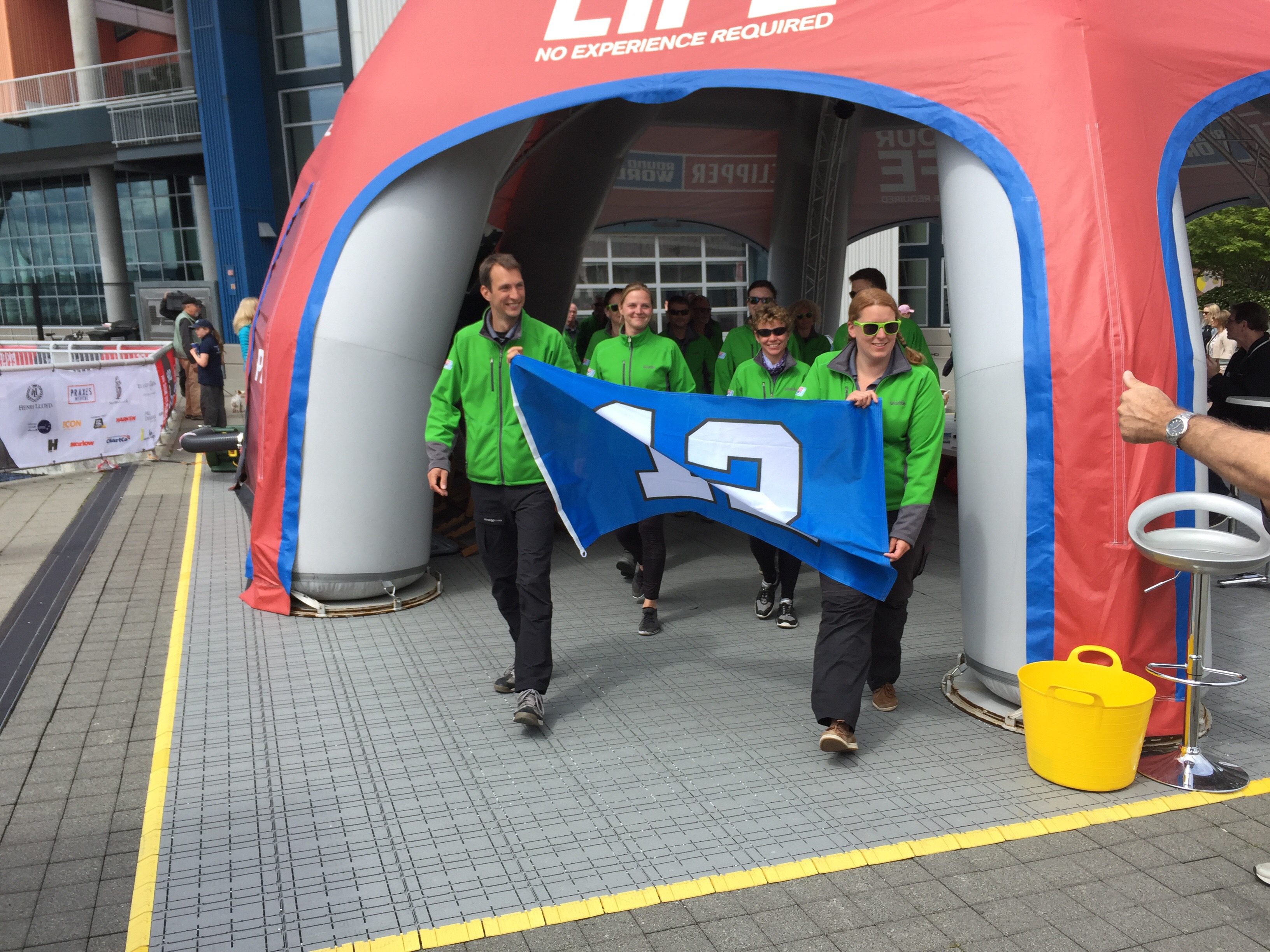
There are promotional materials for me at the race village tent. A gentleman from Florida provides them. His clipper race jacket indicates that his boat was named for a Single Malt Scotch company. The clipper race boat from 2013, known as Old Pulteney, had been rebranded Derry-Londonderry Doire for the 2015 circumnavigation. Ross Ham, one of th old GOATs on Garmin, completed his first circumnavigation on Old Pulteney. When Ross Ham finished the New York to Londonderry leg, on Garmin, he became the first clipper race circumnavigator to have done it again.
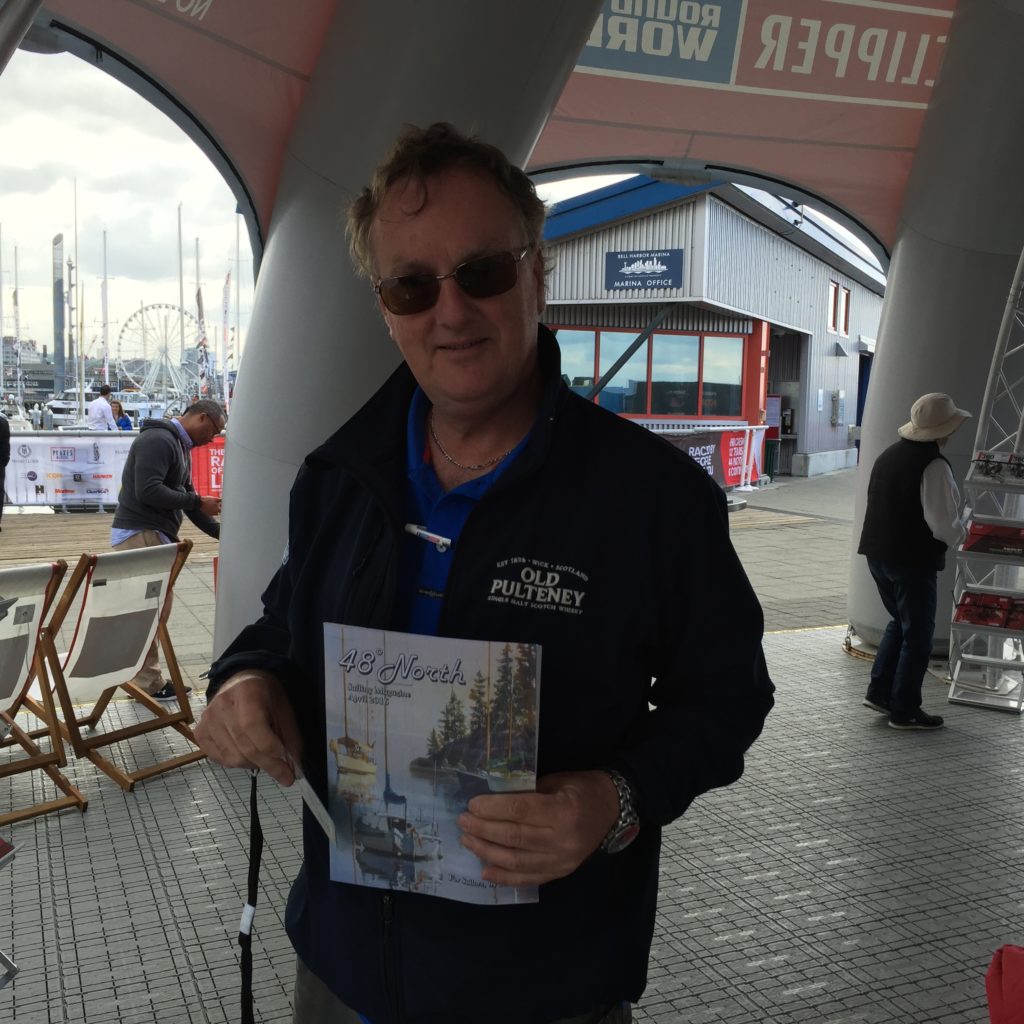
Sarasota Yacht Club Melges Word competitor
I ask the sailor from Florida about the no alcohol on board policy. He confirms that only the Captain may have alcohol and on special occasions tots are provided to crew. Crossing the equator is one. I imagine the Queens 90th birthday, in the summer of 2016, may have been another.
Sailors who are aware of drinking protocol may prefer beer or rum to scotch because of organized religion. Let me explain. In London, an Artificial Inteligence (AI) conference held a single malt tasting event, which I attended. The organizer of the event pointed out that “correct” single malt decision making required an AI program. Drinkers who order single malt by brand are considered right or left footed. This refers to the foot used to dig up the peet moss used for distilling. Catholics are left footed and Protestants are right footed. Which is correct then depends on the organized religion followed.

Alcohol is not allowed on Clipper Race Boats.
Now that the IRA has put down arms, the 2nd largest city in Ireland is worthy of visiting. Sailors who order a single malt at a pub in a Catholic parish are distained by patrons if they order a single malt from a distillery in a Protestant area and visa Versa. Think about ordering a Irish single malt and terrorism. It is best to order Guinness beer.
The story continues with the clipper race boat Derry~Londonderry-Doire. Now that the IRA has put down arms, the 2nd largest city in Ireland is worthy of visiting. The first, Dublin, is where Guinness was invented. The second largest city is called Derry by Catholics, Londonderry by Protestants and DoIre by those not inclined to support either organized group. Clipper race boat Derry-Londonderry-Doire makes us think about the problems of organized religion. In the USA children are still forced to write with the correct hand. It takes decades to work out these notions.
The Melges 24 racer is curious about Clipper Race media coverage and in exchange for a photo I provide a copy of 48 north, one of the local monthly magazines that follow racing. This is the issue where the Clipper 70s are editorialized as overbuilt. Then we chat about if he would do it again.
Since crossing an ocean, he had become a competitive Melges dinghy sailor. In my US Sailing experience, dinghy sailing was for young athletes, learning to sail. You graduated to larger racing vessels eventually crewing on bigger race boats and then cruiser racers as you matured. Eventually you might lease or purchase a vessel for your own sailing adventure. Dingy sailing is a less social sport.
At the highly competitive end it can even be thought of as anti-social. We saw that at the 34th LVACWS when the Oracle and BAR teams demonstrate that ignorance of the racing rules is an asset for someone trying to make a team. The weight of about a six pack of beer was added to a couple of the multi hulled race boats, giving crew on those boats an advantage. The rule violations went undiscovered until the modified boats were repurposed for a youth event. The Oracle and BAR teams had not yet determined who would be on the AC34 boats. The cheeting was relevant in that those on winning weighted boats were more likely to make the final team cut.
Another example is the most recent dinghy-like Volvo Ocean racing. Here the crew of Vestus Wind chose to remain ignorant about navigation, that ignorance being viewed as desirable by team management. To be curious about a function not assigned to you can get you fired from a team managed that way. Ignorance is viewed as an asset. The result was a shipwreck.
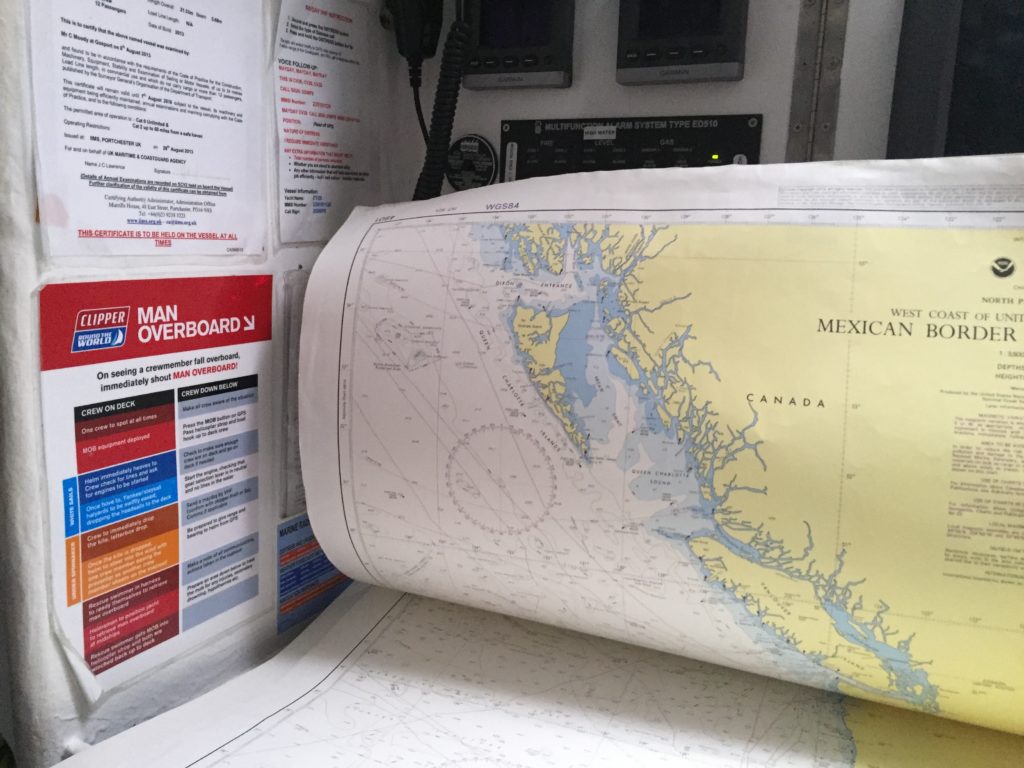
Set of paper charts may have prevented Vestas Wind Shipwreak. They are carried on Clipper 70s.
On Clipper Race boats crew are encouraged to learn all aspects of sailing. Those interested in navigation are given special training where they can run the boat onto “beaches”, the beaches being restricted zones of water, not actual shallows. That kind of beach is used by race management to avoid water hazards. New Volvo Race managers, the old ones eventually moved on, are now doing that post Vesta Wind shipwreck. Unlike the Vestas Wind shipwrecking Volvo Océan Race, Clipper Race management monitors boat position at all times, even when in stealth mode, which prevents other race boats and fans (and pirates) from knowing a boat’s position.
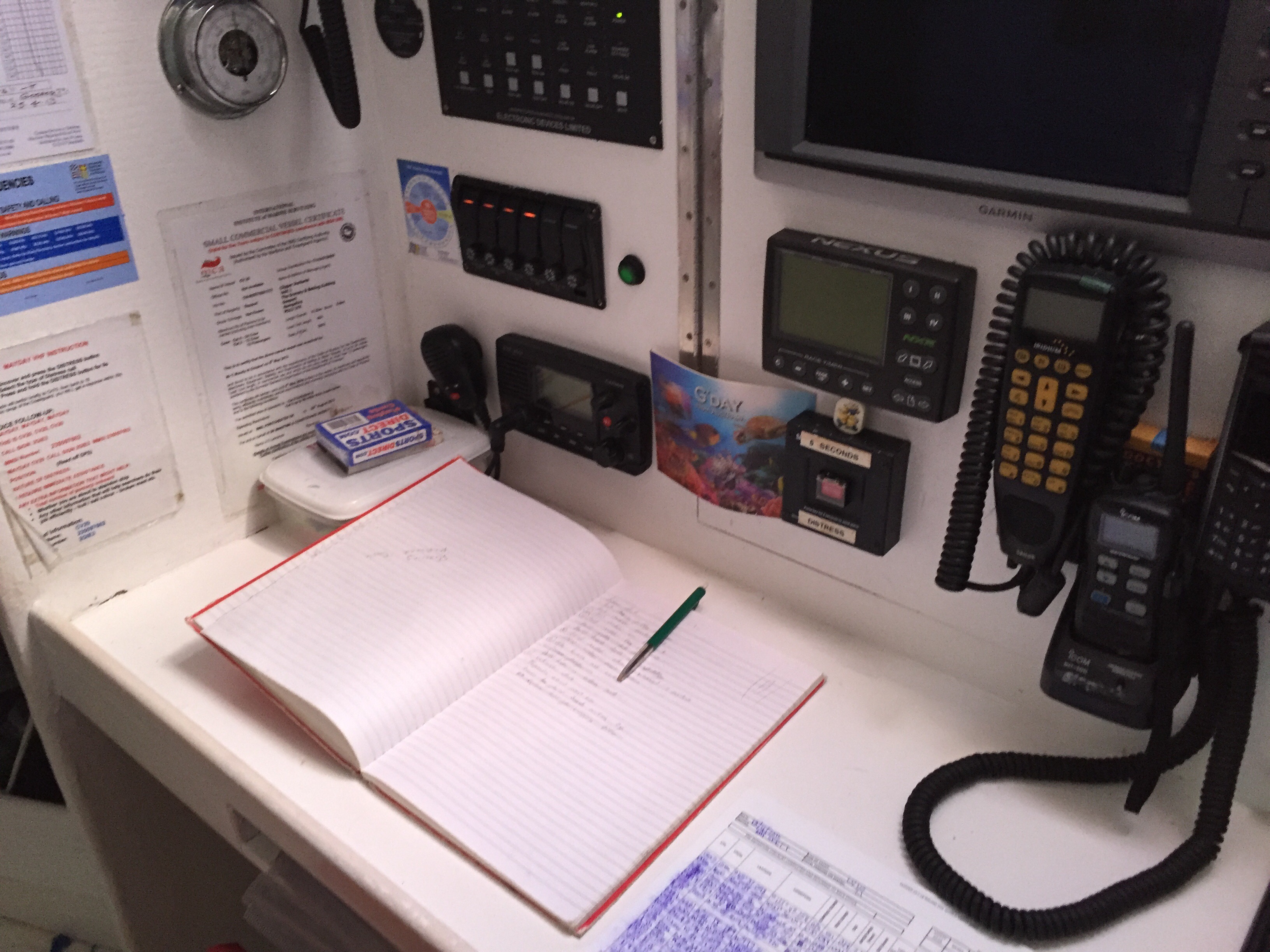
The Florida clipper ship representative enjoys his Melges 20 and has sailed her in World Competitions and has prepared the boat for the Florida Words but will likely sell the boat to a Worlds competitor. He wil not be competing this year. In normal wind he has been clocked at over 20 knots. He would cross an ocean again but wants to do it in a Volvo Ocean race boat which, like his dinghy, can maintain such speeds when the wind is following. The current Clipper race boats are clocked at that speed when surfing down waves but average just over 7 knots. He speculates that VOR builders hope to provide VOR boats for future Clipper Racing. A VOR racer had been provided for a celebrity charity event. He then tells me that he wants a 30 foot cruiser to take his wife out in. She will no longer be a sailor’s race day widow. I learn that he was born in Canada but intends to retire in the USA.
The USA is different from other nations, including Canada, not just in gun ownership and health care but also owing to the values held in common by her people. Individual effort is counted more than team effort. Hence, we have a game like baseball and track statistics by individual player. Team wins are secondary. We also have inheritance taxes that make it difficult to become powerful, like a King, just by birth. The American Dream is that by ones drive, intelligence, talent, perseverance and luck a law abiding citizen can rise to become a champion – like a sailing Olympic champion.
American sailing has a long history of Olympic domination: No country has won more total medals than the United States. We lead the count when it comes to silver and bronze medals. Only Great Britain holds more gold. Since 1932, American sailors have won medals in every Olympic regatta in which they’ve competed, but not in 2012. Getting skunked was inevitable. The warning signs were there, but it took a kick in the ass to prompt action.
Revitalizing American Olympic Sailing, Creg Lewick, Sailing World
Hence, when the USA was unable to win a single dinghy race meddle in the Olympics, Americans felt that something was wrong.
One feeling was that athletes on the US Sailing team had been selected by means other than fair competition. An institutionalized, under the table system of selection explained the results. Such a system does not support the American Dream. It means an athlete must entertain patrons who can influence team management. Patrons who are like royalty, at least within the sport. The number of US athletes calling themselves sailors started dropping by 10,000 per year. The sport just wasn’t seen to represent US values. Sailboat racing was being viewed as an activity reserved for Royalty, even in the Olympics. Owing to the leadership President Jannet Baxter, the firm of Makinsey & Company was called in to investigate and report findings to US Sailing members. This was in 2004.
The finding of most significance was that a substantial amount of Federal money given to the US Sailing organization for the Olympics could not be accounted for. Continued Federal funding was at risk. The remedy was to reduce the number of board members, in a manner then common for corporations, so that remaining individual members could be held accountable.
Shortly after the reorganization, US Sailing cut off funding for big boat racing where some of the missing federal funds earmarked for the Olympics may have been diverted. The King of Spain was a huge advocate of big boat racing and the Panama Papers are enlightening.
The law firm that created the Panama Papers is well known for transactions involving vessels.
One of the common reasons to set up a Panama Papers style account is to avoid taxes, like sales tax on a sailboat purchase. But there are more sinister reasons. An offshore corporation may be set up to avoid laws related to labor and safety and the environment which apply otherwise or to launder money. The King of Spain’s family set up an account to launder money. The Panama papers show royalty transactions.
To save the monarchy, when news of the laundering surfaced, the king of Spain resigned, as king and as advocate for big boat sailboat racing.
The 2004 fleet of TP52s had been designed by six different naval architects and the boats had been built in six different yards. The European fleet was aided enormously by the efforts of H.M. Juan Carlos, King of Spain. The King took it upon himself to develop TP 52 brochures that included information about how the box rule worked, provided a list of existing TP 52s with photos, and the entire text of both the TP 52 Box Rule that was developed by the Transpacific YC and of the Class Association Rules. The Panima Papers may show how those he gave brochures to financed the TP52s.
The country for which the vessel is registered, not only determines tax, but also sets the standard for its safe operation. the Cayman Islands is the country of registry for Vestus Wind. This country requires a minimum safe manning document MSMD for sport vessels over 24 meters in length. The VOR boats are smaller than that. Hence European standards, Indeed all standards regarding captain and crew, are avoided by registering in the former British Territory now called the Caymens. The shipwreck called attention to Panama papers style trickery to go along with a team culture that discouraged curiosity about others jobs. A culture not unlike Monarchies.
The entire endeavor was tarnished. I doubt VOR race boats can be considered suitable for Clipper Race use. The shipwreck showed them to be fragil. They were built quickly and likely without serious oversight, similar to the first TP52s. The VOR has new race management but the notion of having another ocean crossing race using the same boats will likely and should die. When I viewed the “overbuilt” Clipper 70s, they were completing their second circumnavigation, and eliminating VOR features like carbon fiber bow sprits. If there is to be another VOR, and that is far from certain, management should consider boats with hulls and rigging similar to Clipper Race Boats, not visa Versa.
Johnstone met the Clipper Racers in New York after the boats transited the Panama Canal. He likely had put together relivations from the Panama Papers with what might happen when his Clipper Racers returned to Britain. Before I chatted with him on the docks at Seattle’s Bell Harbor, there had been speculation published in the International Business Times that Britain might exit the European Union because of “The suggestion that David Cameron is part of a wealthy elite or is someone who may have connections to large sums of money that is already priced into British politics (Matthew Goodwin 6 April 2016). This suggestion was expected to harden voters against Cameron’s efforts to keep Brittan in the European Union. British Prime Minister, David Cameron, had sent a message of support to Clipper Race Chairman Sir Robin Knox-Johnston and the crew members taking part in the Clipper 2013-14 Round the World Yacht Race. “Johnstone said at the time that “The Clipper Race is working closely with the government’s GREAT campaign to leverage our global race platform and boost the visibility of British tourism, trade and successes abroad. We join the Prime Minister in wishing all our crew members the very best in their endeavours.” When the 2015-16 racers crossed the Atlantic the Brexit vote took place. Tweets from race participants demonstrate that exit from the union was not expected. Cameron was out by July 13 2016.
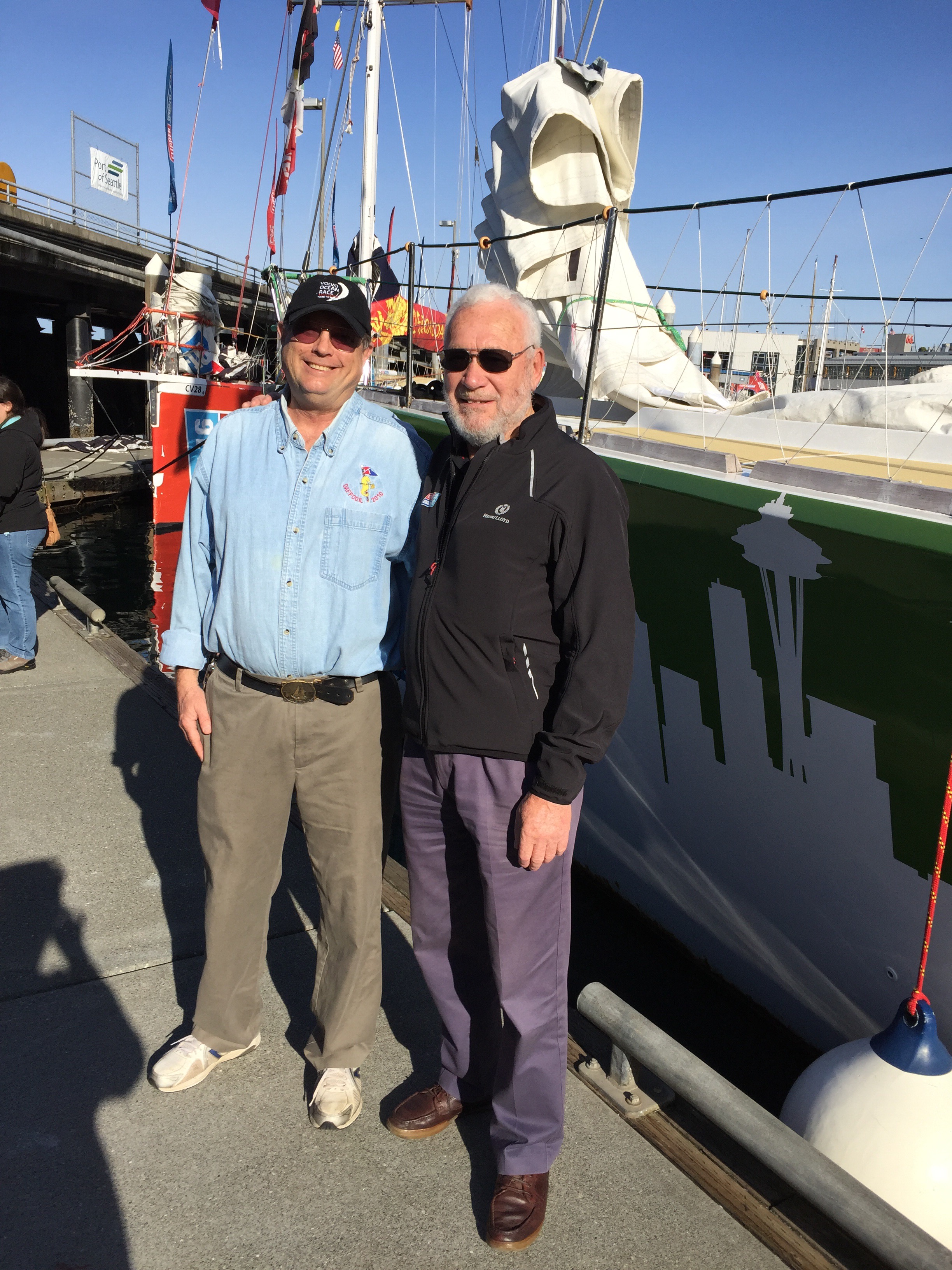



https://flip.it/nUnZWF
https://static.independent.co.uk/2023/09/03/12/03115324-6c022a12-07de-40b8-a48f-e4c0cd960dda.jpg?quality=75&width=990&crop=3%3A2%2Csmart&auto=webp
https://www.independent.co.uk/news/uk/world-wrexham-atlantic-ocean-washington-dc-lincolnshire-b2404058.html
https://media-cldnry.s-nbcnews.com/image/upload/t_fit-1240w,f_auto,q_auto:best/rockcms/2023-04/230424-bud-light-jm-1627-44f869.jpg
https://flip.it/A2FT-N How Bud Light made its true feelings about Dylan Mulvaney depressingly clear
https://pin.it/5IBeEAP
https://flip.it/Olqt3a